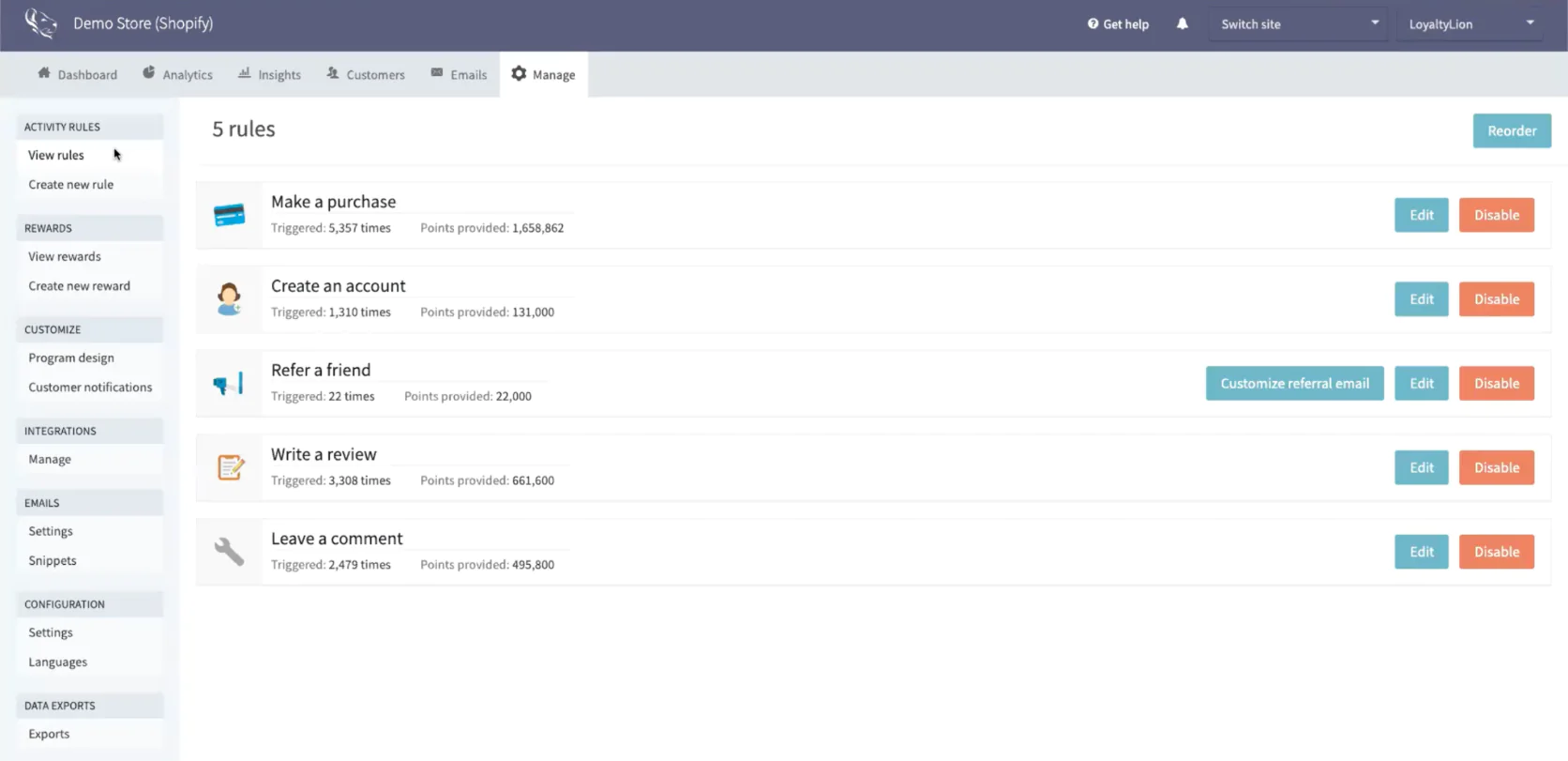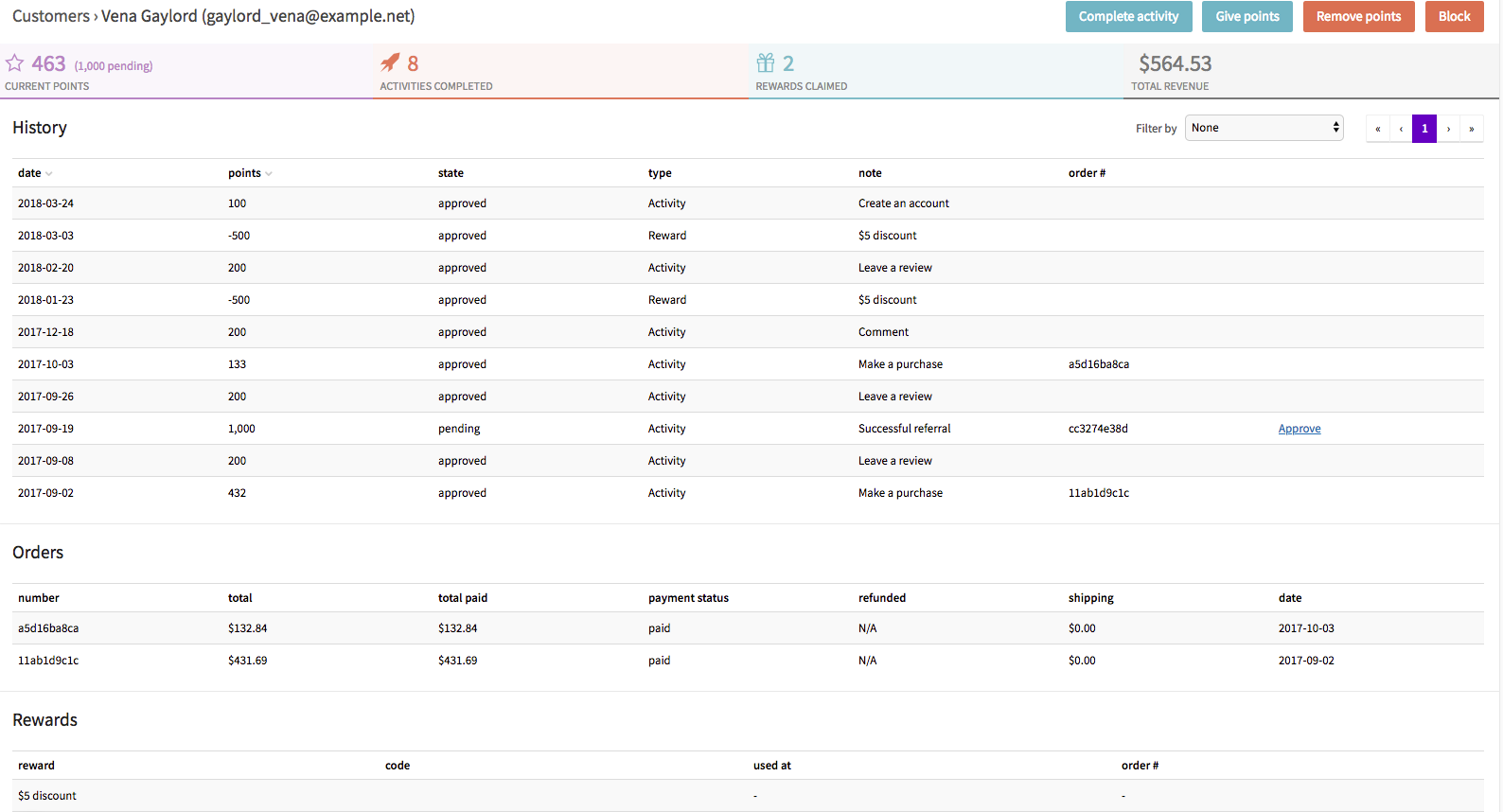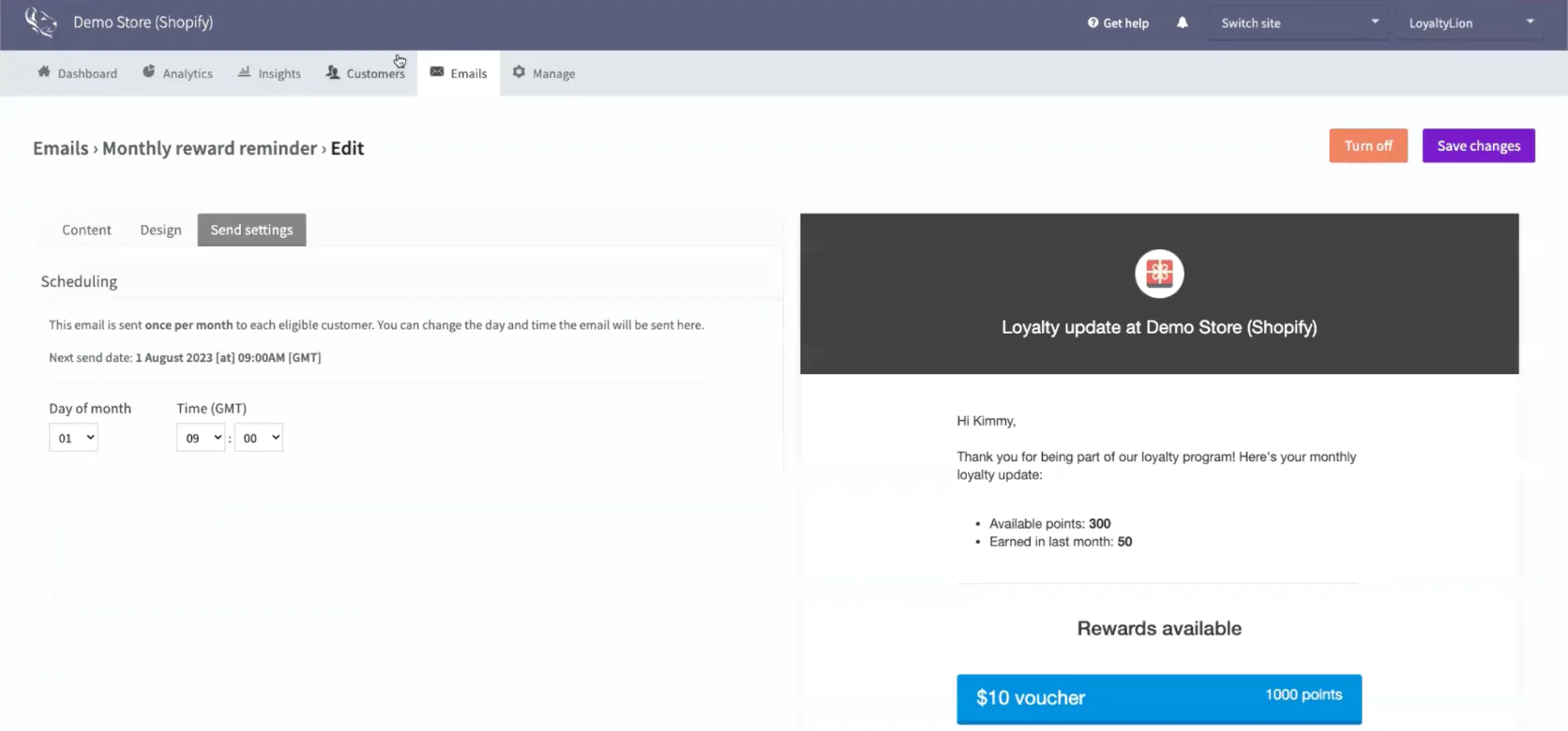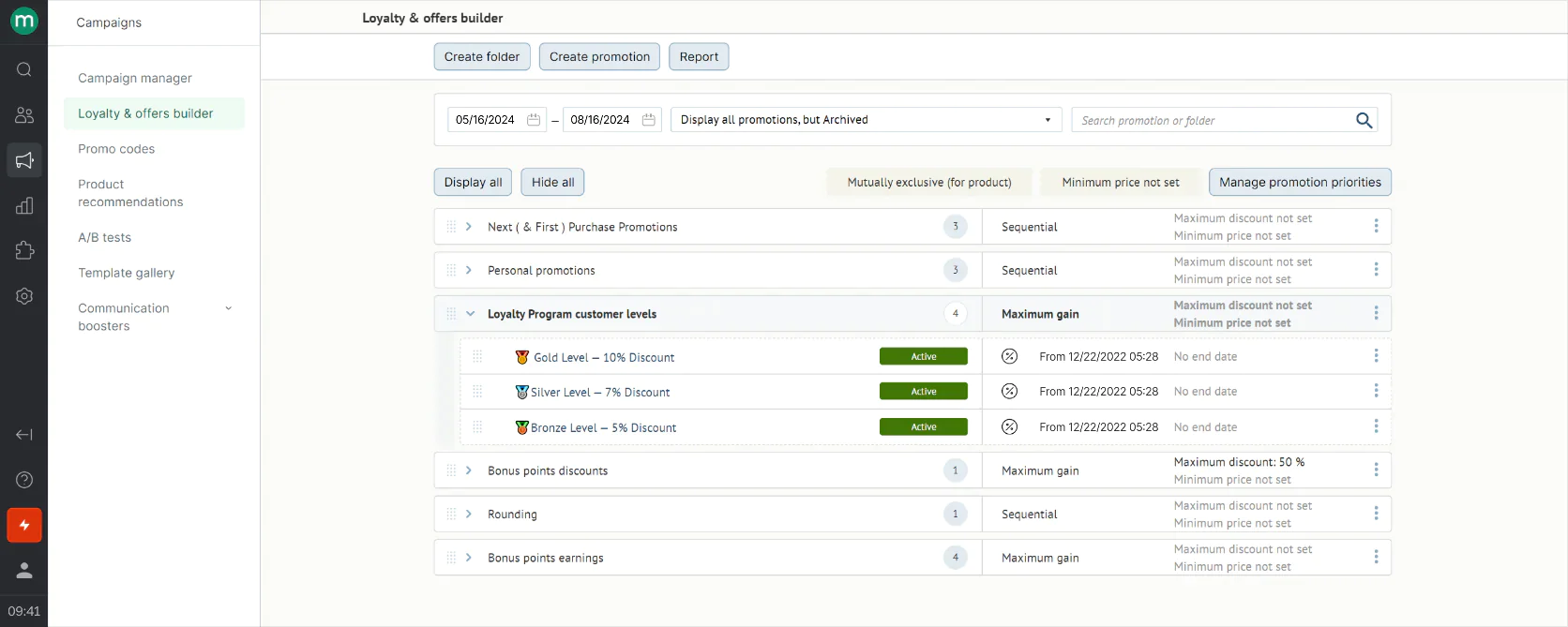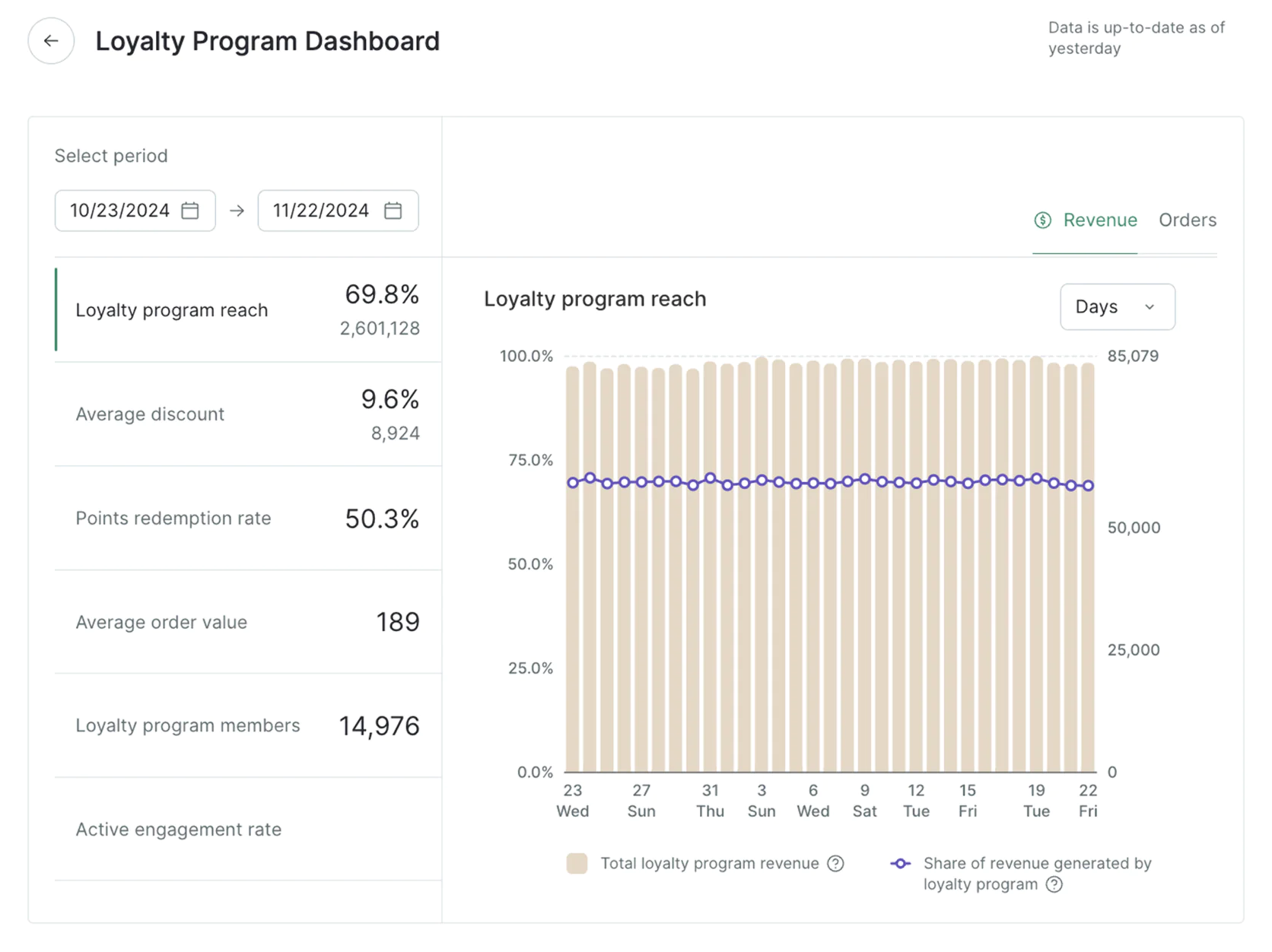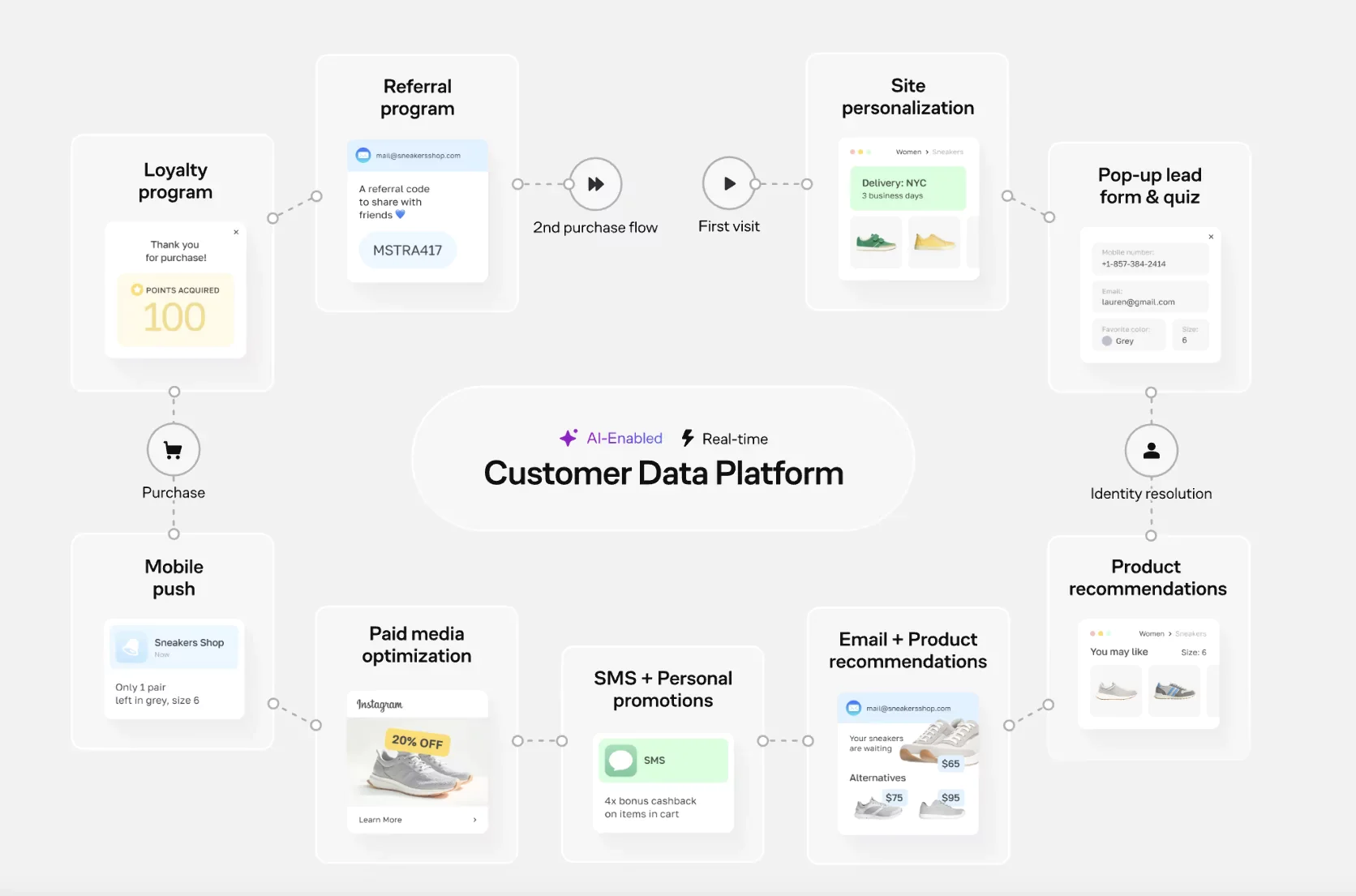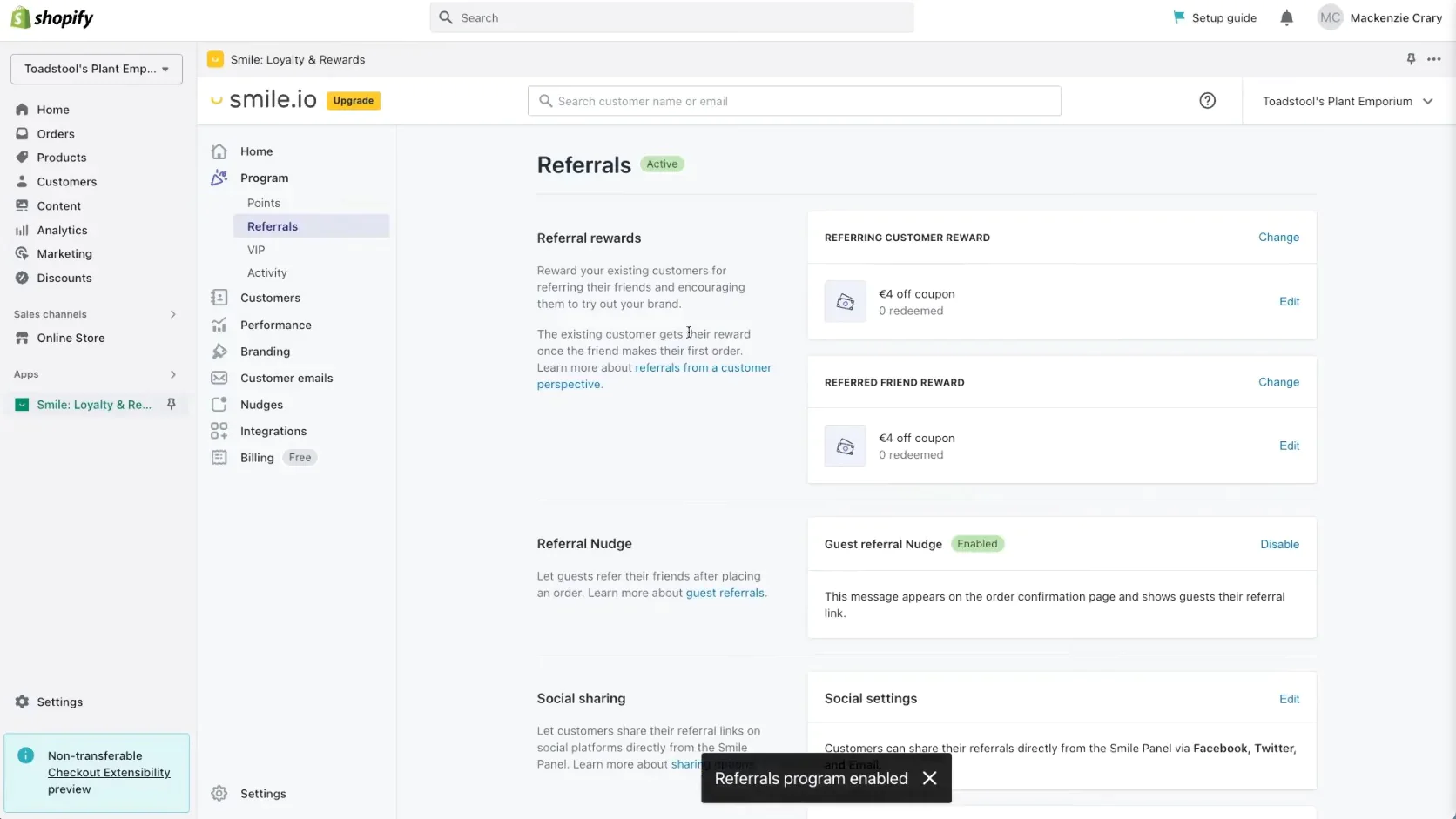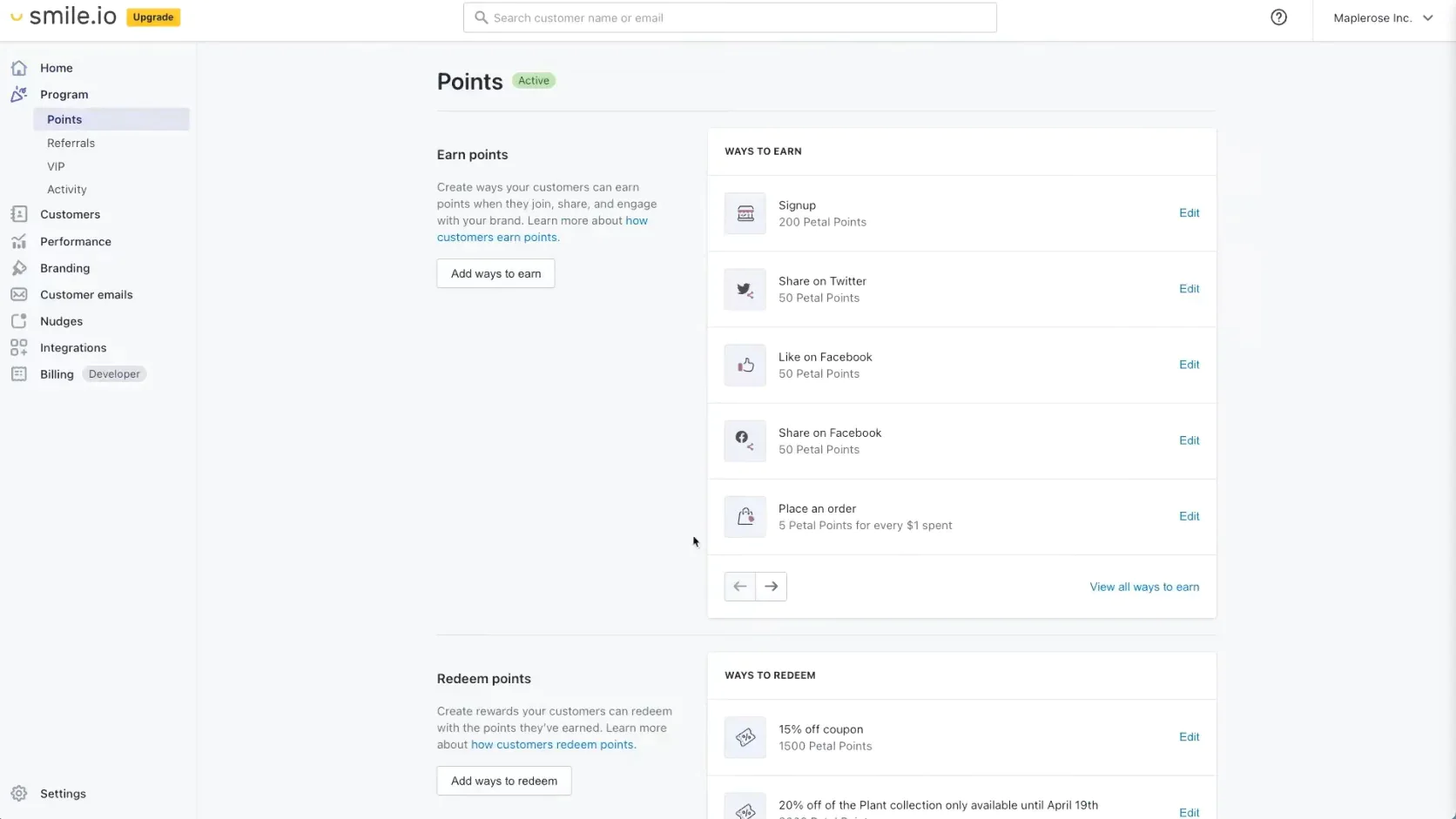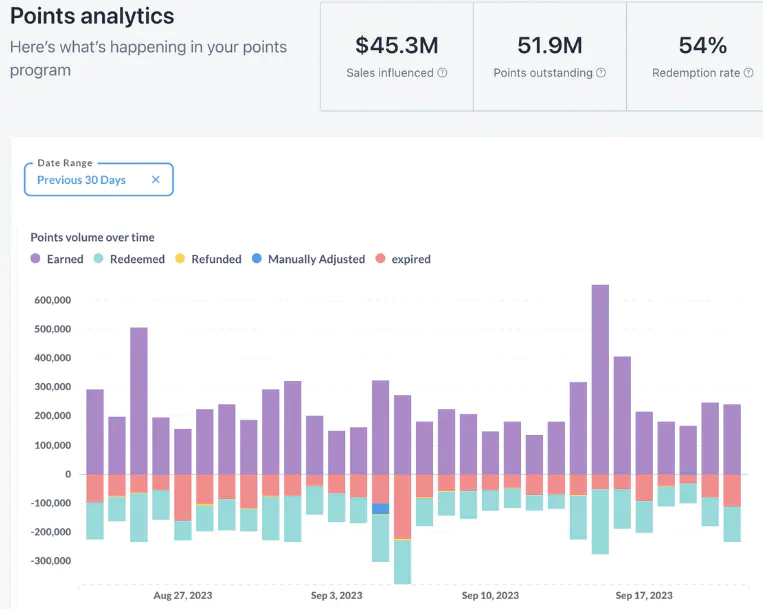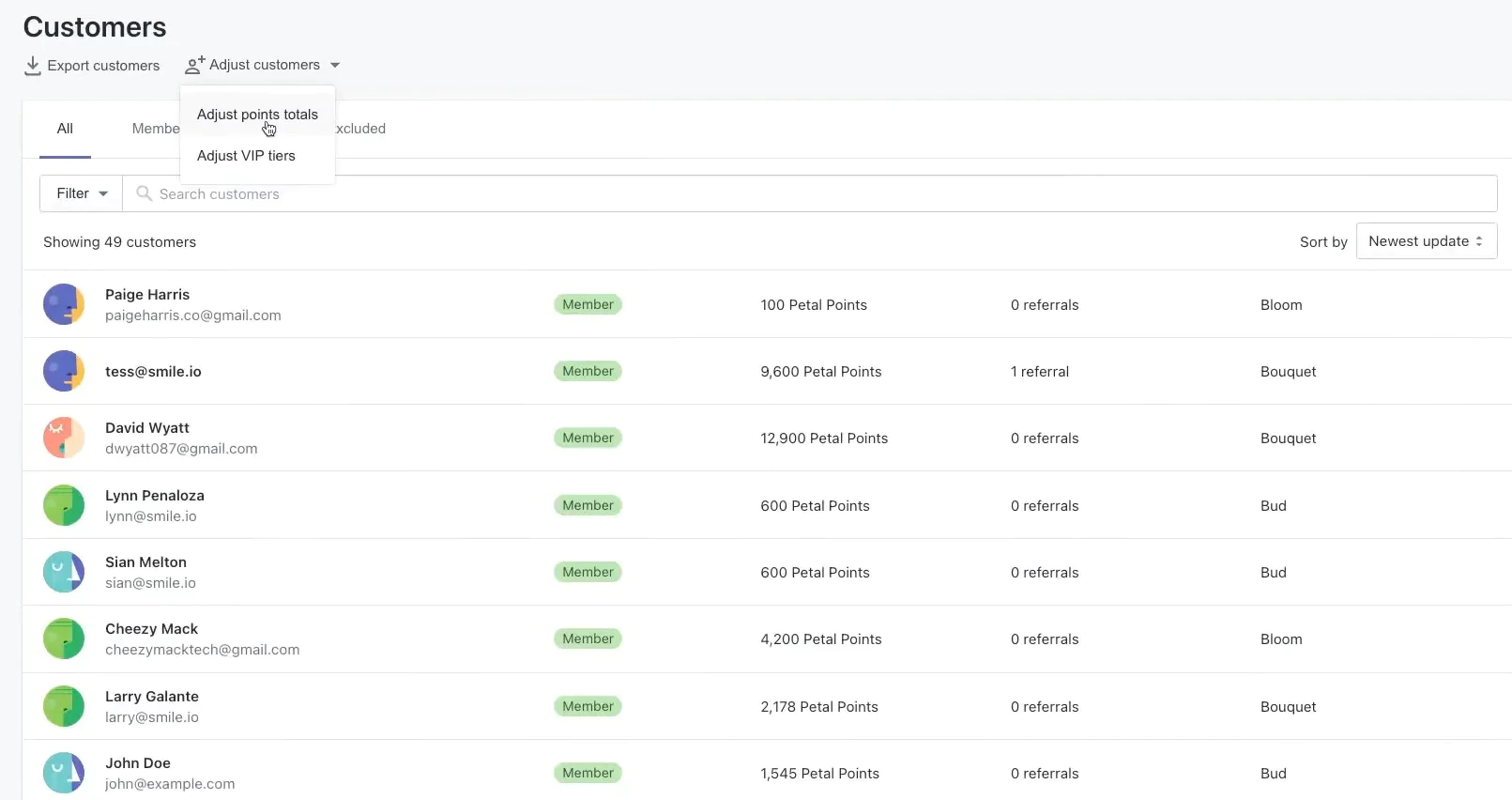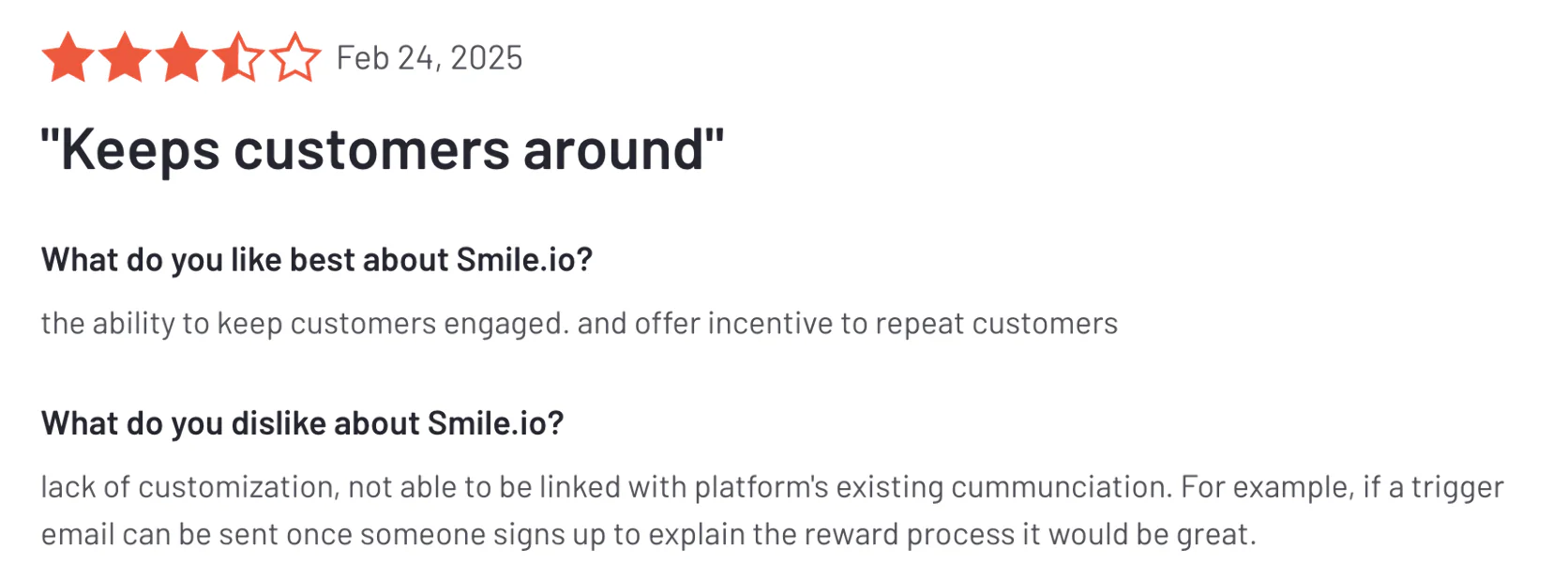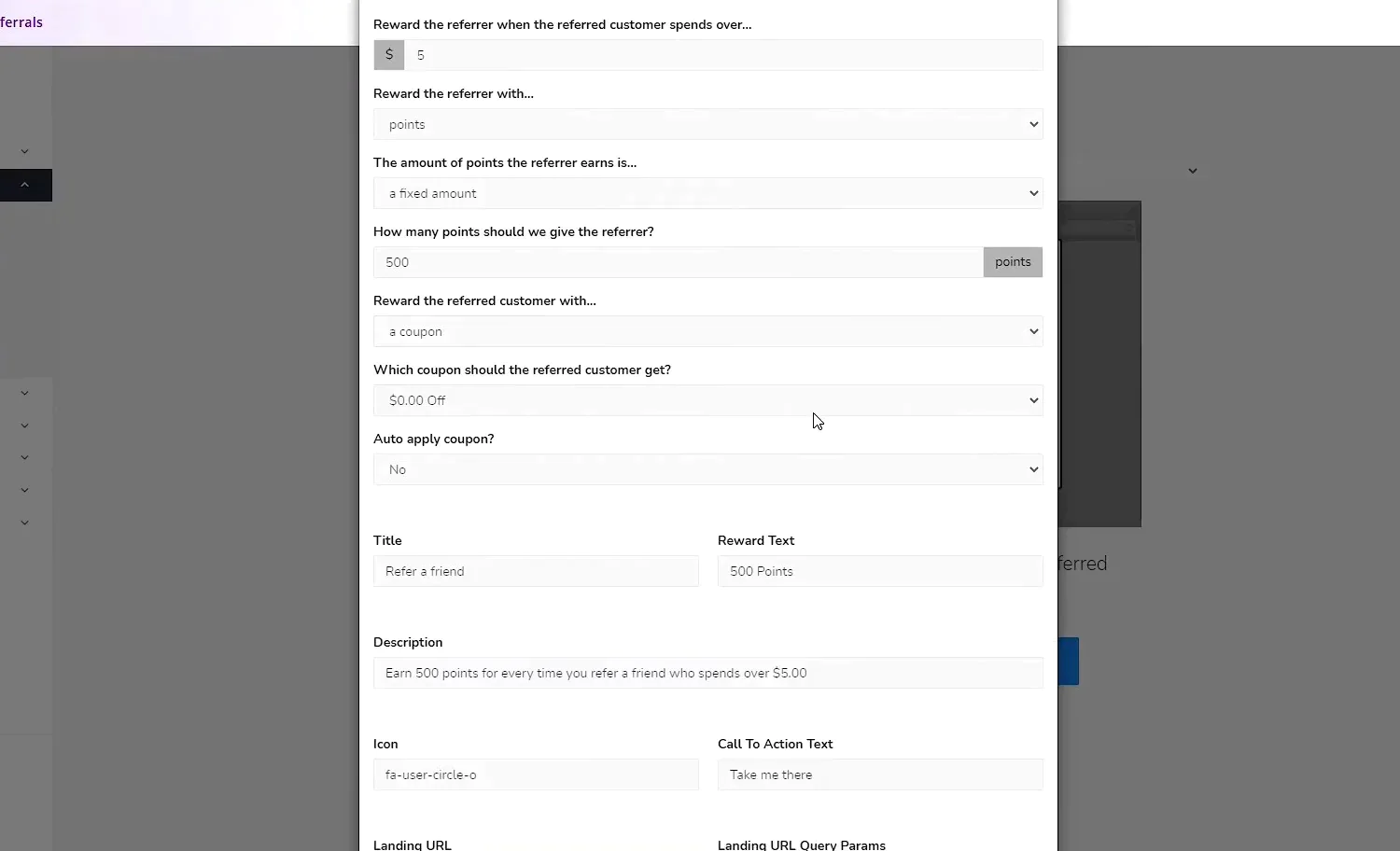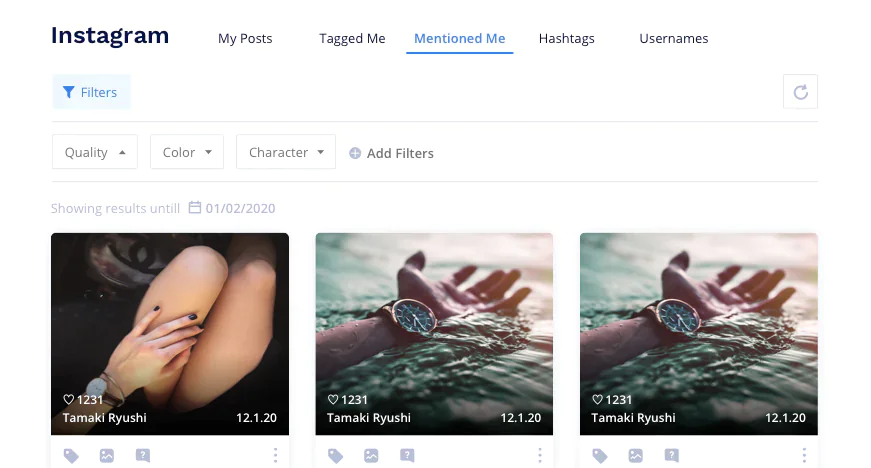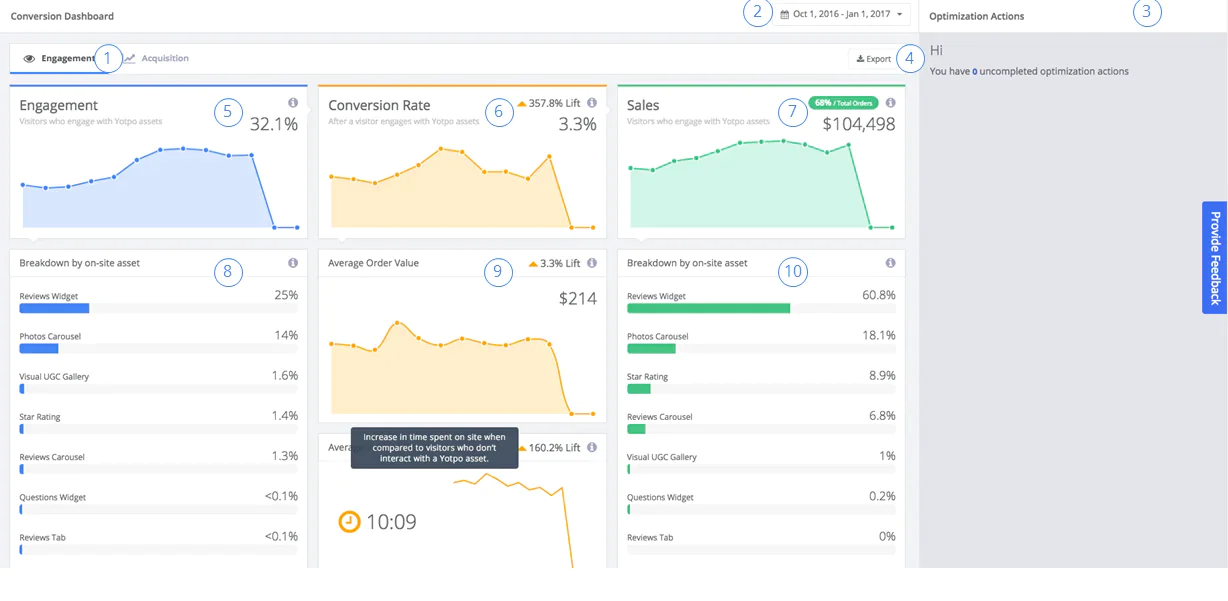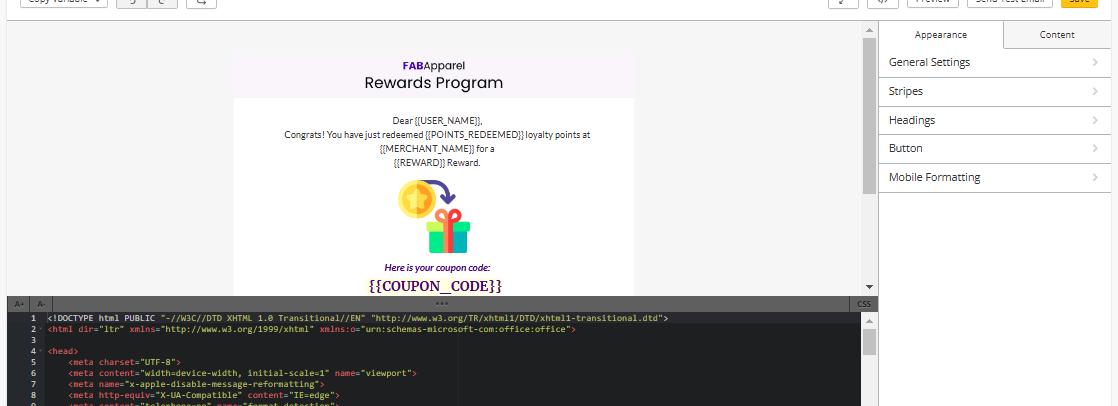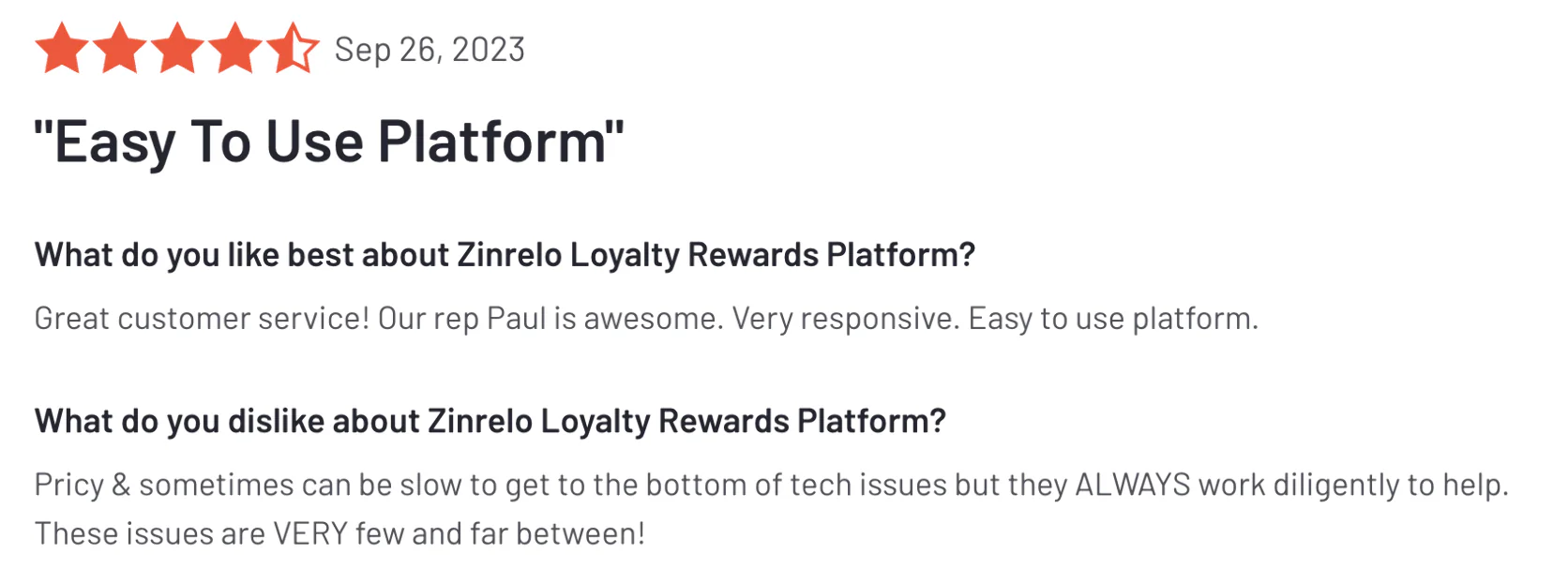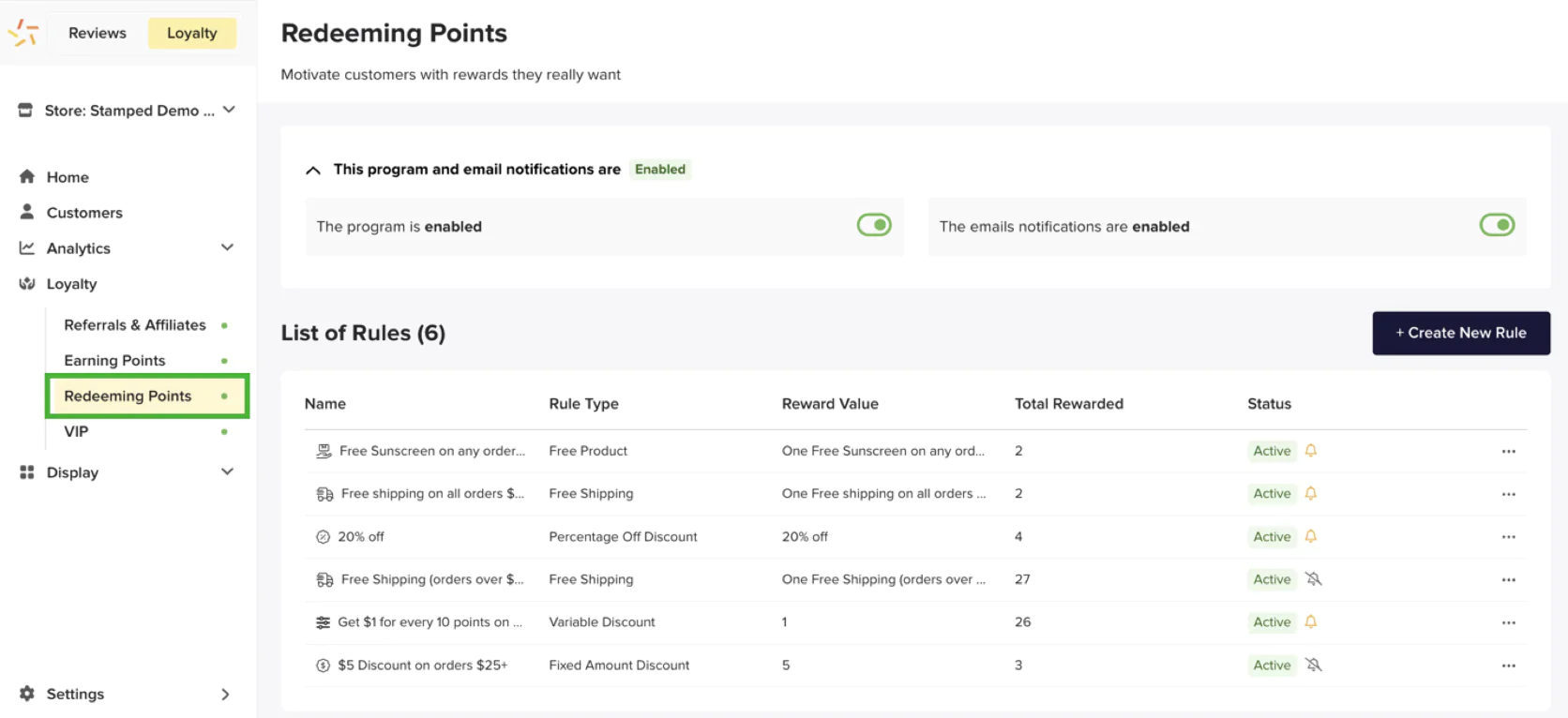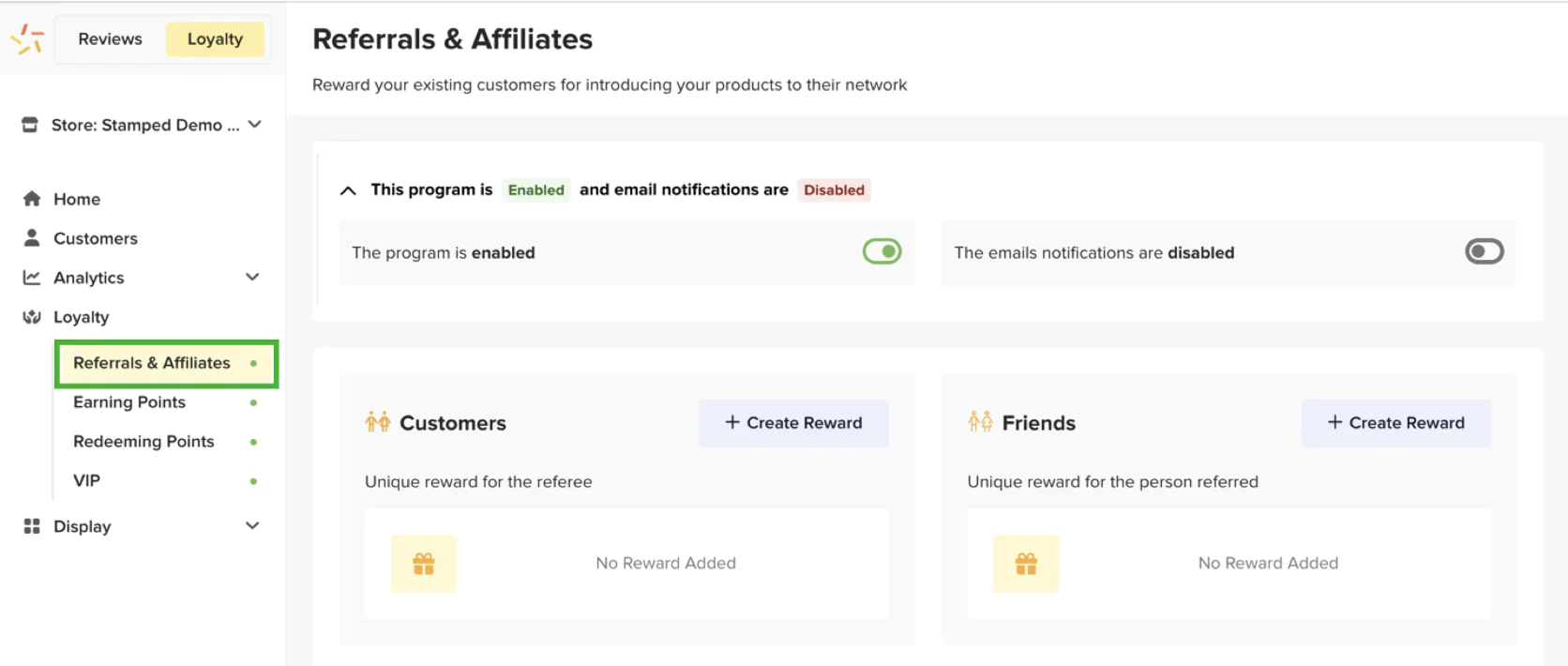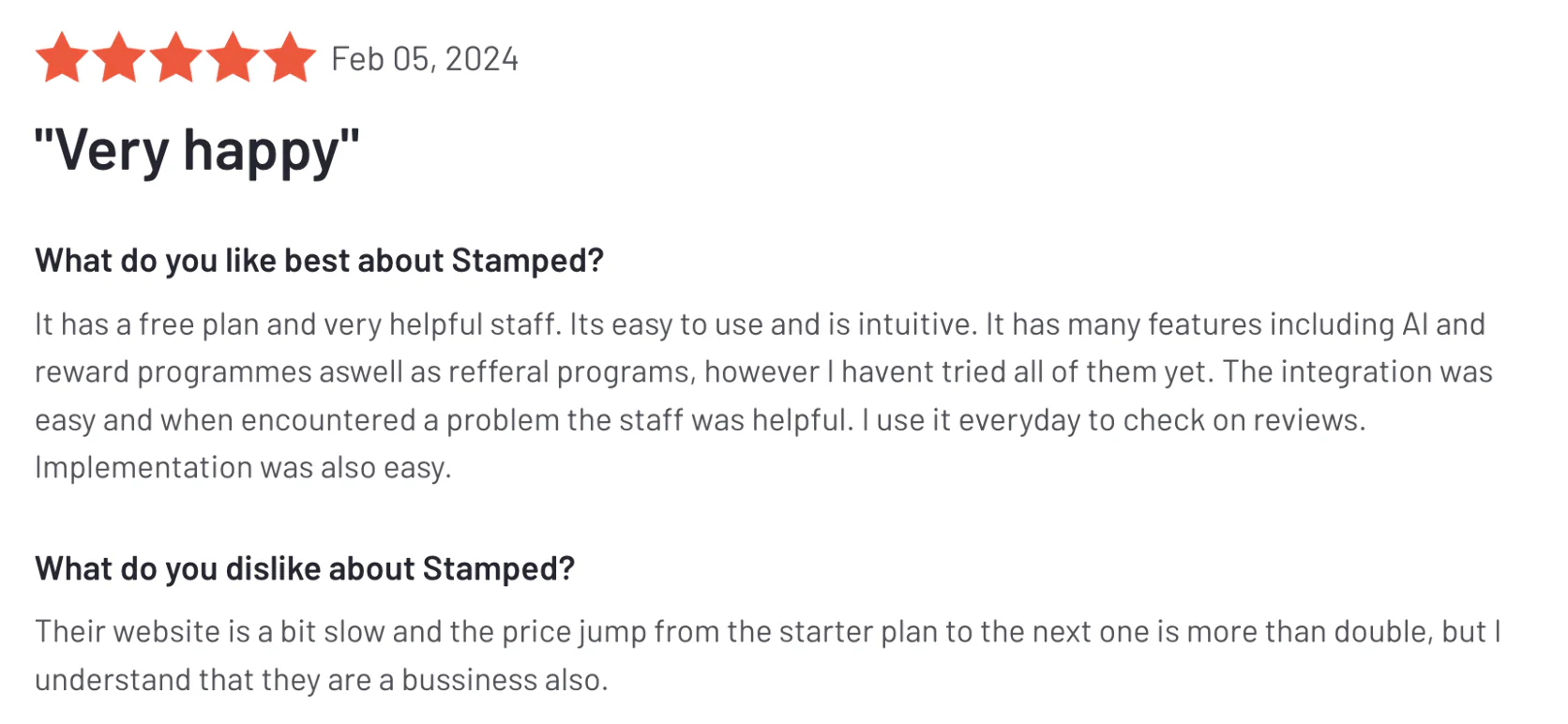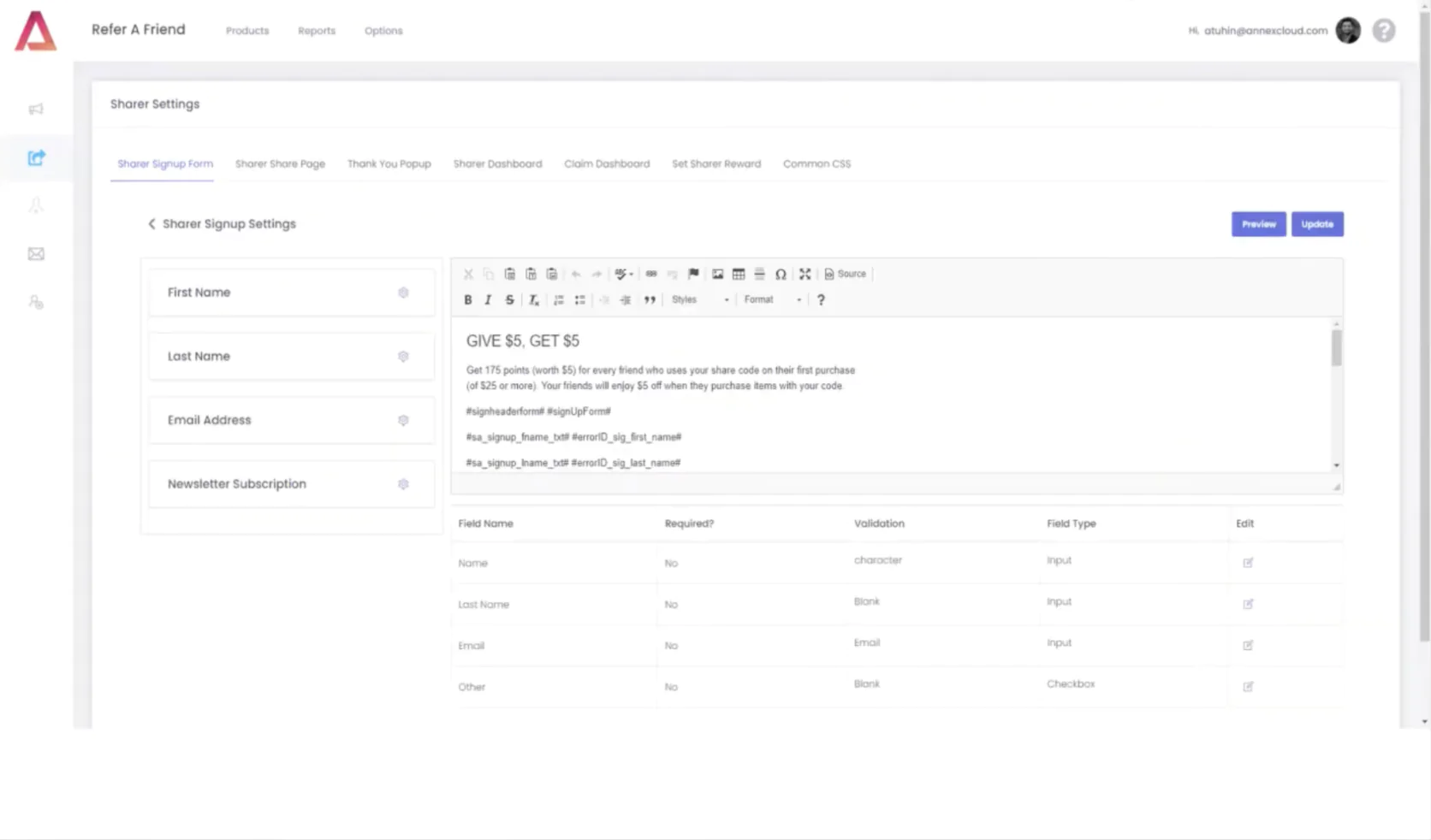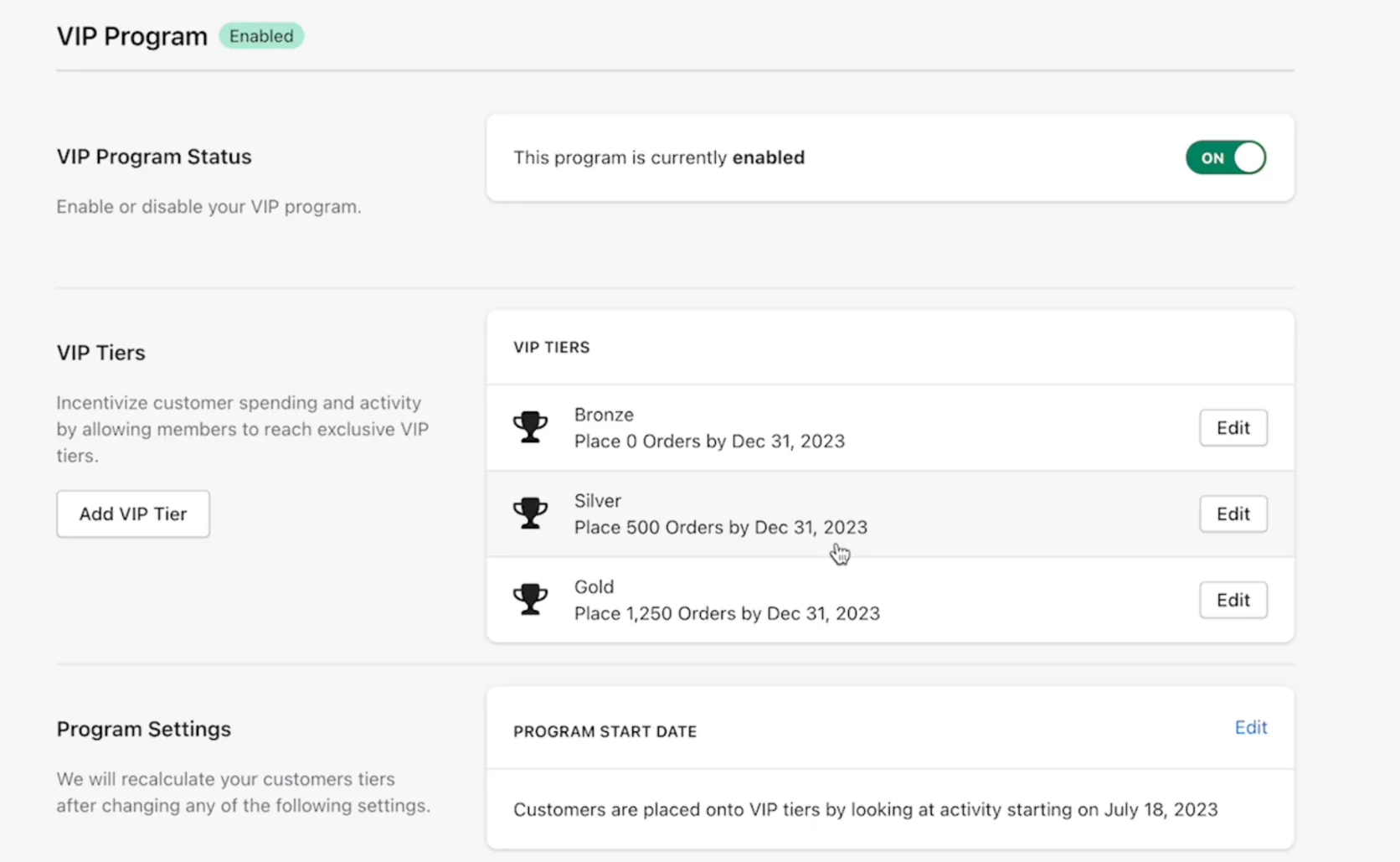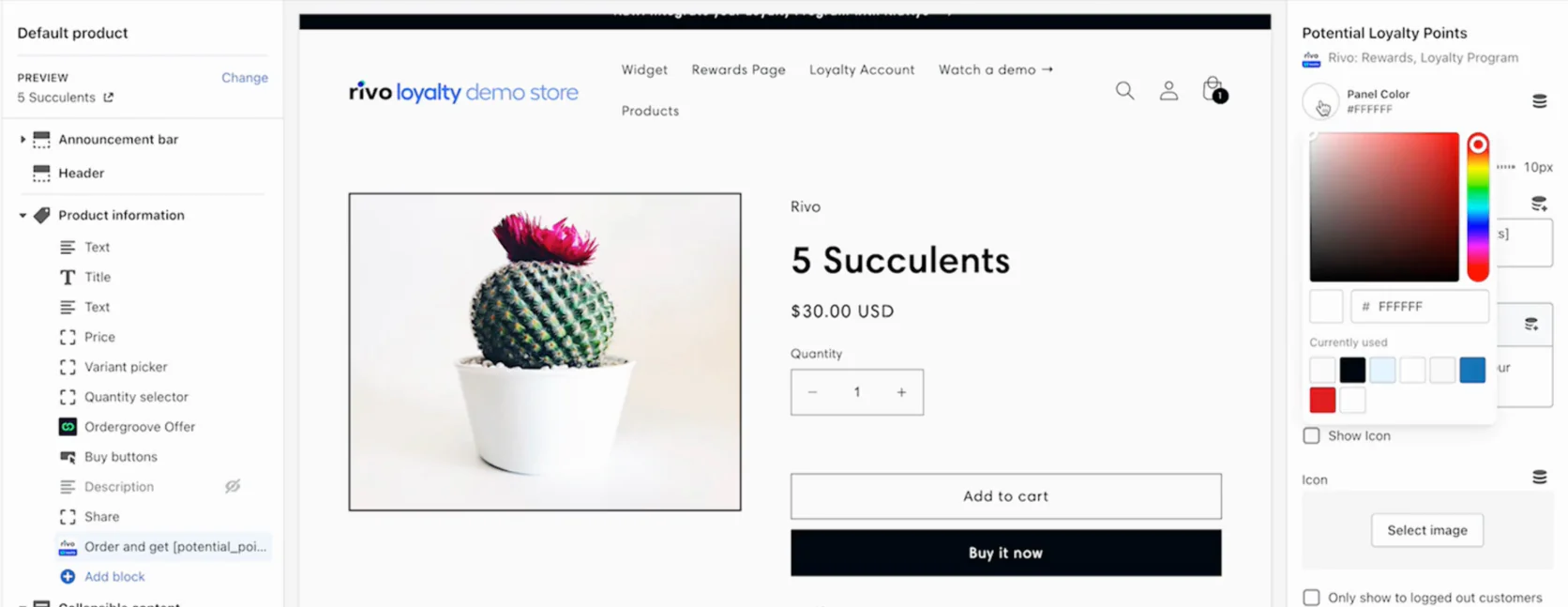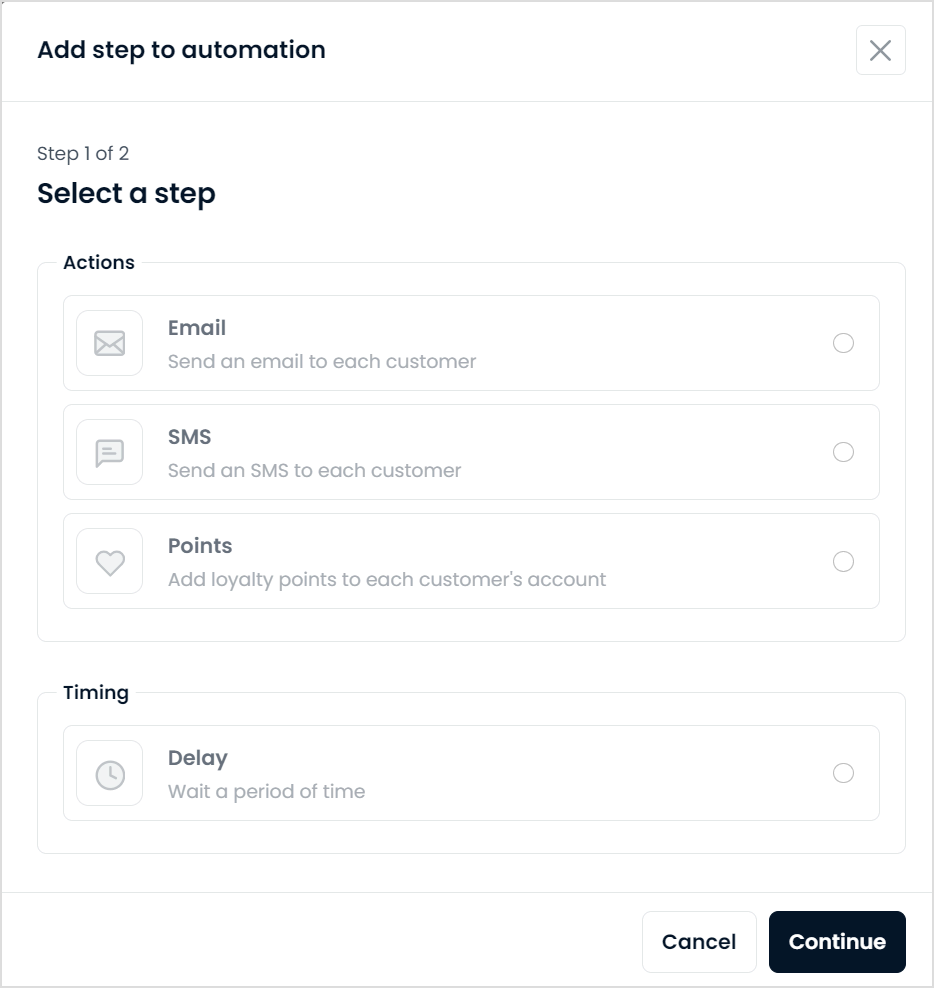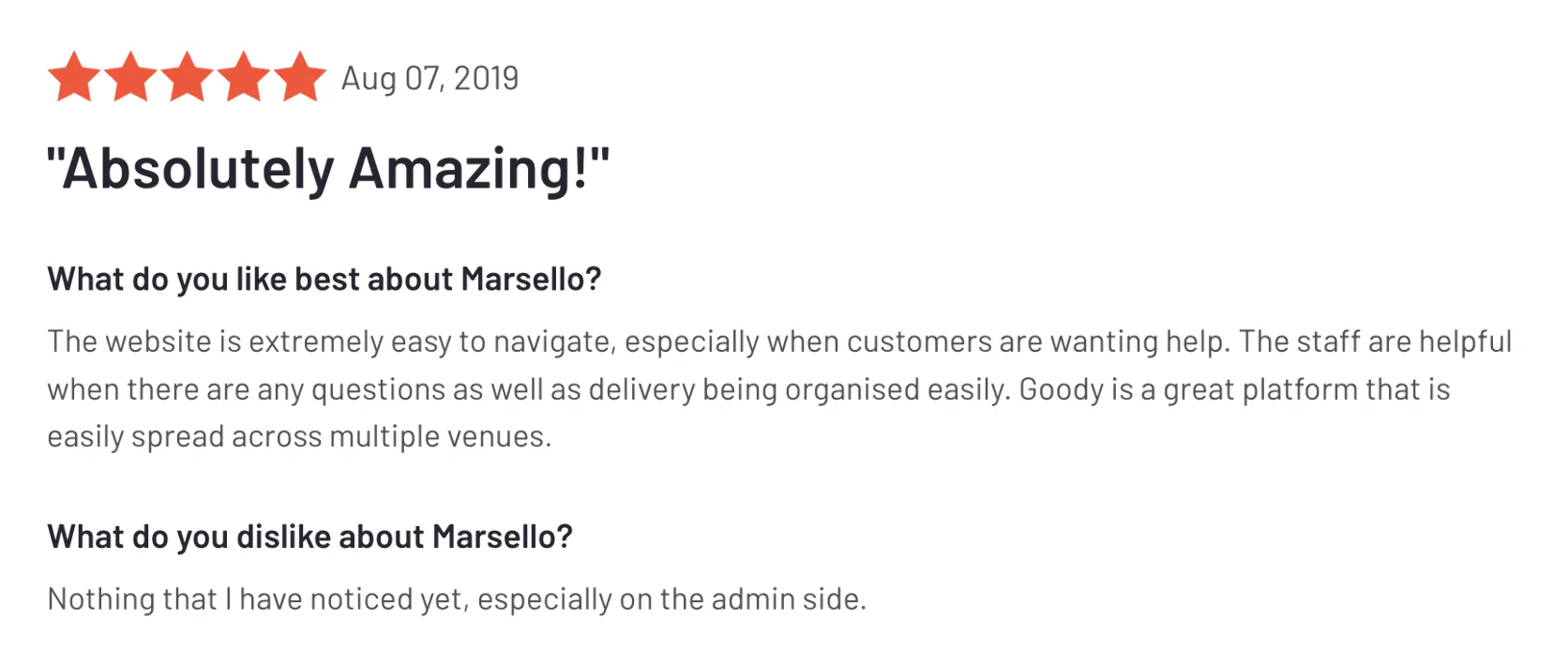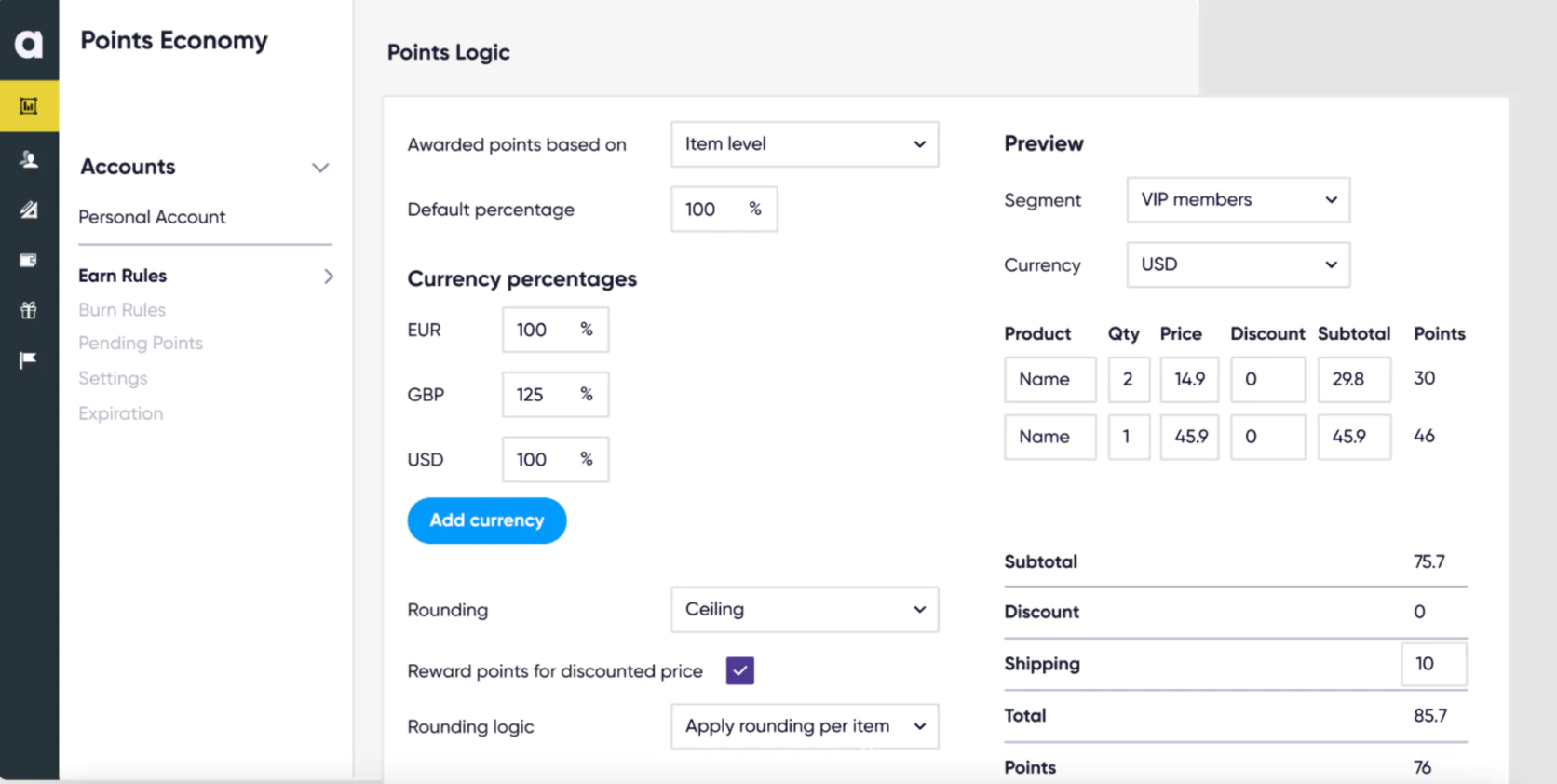Top 10 LoyaltyLion Alternatives for 2025
In 2025, relying on a single point-based app like LoyaltyLion can start to feel limiting. Brands are seeking more flexibility, deeper customer insights, and better value for their loyalty programs.
In this article, we break down 10 top alternatives to LoyaltyLion that address these needs. Some bring fresh approaches to loyalty and retention, others can save costs or unlock new channels.
We’ll cover the pros, cons, and ideal use cases for each alternative, and how they compare in critical areas like integration flexibility, analytics, personalization, and total cost of ownership. Let’s dive in.
LoyaltyLion is a leading customer loyalty and engagement platform, specifically designed to support e-commerce merchants in enhancing customer retention and driving business growth.
Managing rules in LoyaltyLion
It is particularly noted for its integration with Shopify, where it has been empowering brands worldwide for over a decade. The platform aims to turn one-time buyers into loyal customers through data-driven loyalty programs, making it a staple for online retailers seeking to boost repeat purchases and customer engagement.
LoyaltyLion offers a comprehensive suite of features to facilitate effective loyalty programs, including:
Customizable loyalty programs where customers earn points for actions like reviews, referrals, and purchases.
Referral programs to encourage existing customers to bring in new ones.
Integration with tools like Klaviyo for automated loyalty emails and other platforms like Gorgias and Attentive.
Detailed analytics to track customer activity and program performance, aiding in strategic decisions.
A personalized loyalty page that integrates seamlessly with the merchant's Shopify store, enhancing the shopping experience.
Customer’s actions in LoyaltyLion
LoyaltyLion's strengths are evident from its market position, particularly within the Shopify ecosystem. Key strengths include:
Ease of Use: Users frequently praise the platform for its user-friendly interface, making it easy to set up and manage loyalty programs.
Customer Service: Generally, the platform is noted for responsive and helpful customer support, with some users mentioning quick assistance during onboarding, as seen in Shopify App Store reviews.
Effectiveness in Engagement: It is effective in driving customer engagement and repeat purchases, with claims of generating $15 for every $1 spent on the platform, as noted on Capterra.
Market Leadership: Rated #1 for loyalty on G2 and with over a decade of experience, LoyaltyLion has established credibility, particularly with its early integration with Shopify.
Creating reward reminder in LoyaltyLion
Despite its strengths, LoyaltyLion has some noted weaknesses based on user feedback, which could impact its suitability for certain businesses:
Limited Customization: LoyaltyLion provides a robust set of tools, but certain improvements could increase its adaptability. For instance, the inability to schedule double-point events, or exclude specific products or categories from particular rewards.
Cost Concerns: The pricing model, starting at $199/month for the Classic plan and going up to $399/month for higher tiers, may be prohibitive for smaller businesses. This could limit accessibility for startups or low-volume merchants.
Why look beyond LoyaltyLion
Today’s mid-market and enterprise retailers need loyalty solutions that do more than just tally points. They need to integrate seamlessly with email, SMS, apps, and in-store systems, harness AI for personalization, and offer transparent pricing as programs grow.
Many brands find LoyaltyLion’s pricing climbs quickly as they add features or members.
Its focus on loyalty alone means juggling multiple tools for email, personalization, or analytics. And while LoyaltyLion’s tiered rewards and gamification are strong, some report that advanced capabilities (like sophisticated segmentation or real-time offers) are lacking for larger-scale needs.
In short, 2025 demands loyalty platforms that are more unified, intelligent, and scalable than what a one-dimensional plugin can offer.
The Alternatives at a Glance
Below is a comparison table summarizing these 10 alternatives across key criteria:
Mid-market & enterprise needing unified marketing + loyalty
• All-in-one (loyalty, email, SMS, personalization);
• Real-time segmentation;
• Dedicated CSM, white-glove support
Needs additional tool for UGC display
$2,990/mo (no free tier)
Small to mid-sized e-commerce brands (Shopify, etc.)
• Easy setup, very user-friendly;
• Affordable, with free plan;
• Solid points & referrals basics
• Advanced features locked in higher tiers;
• Primarily online only (limited in-store);
• Widget approach may limit custom UX
Free up to ~200 orders; Paid from ~$49/mo
Brands wanting loyalty + reviews together (Yotpo suite)
• Integrates loyalty with reviews/UGC;
• Robust features (VIP tiers, referrals) on high plans;
• One vendor for multiple solutions
• Pricing is complex and can get expensive;
• Steeper learning curve;
• Many features gated to higher plans
Free for 100 orders, then $29/mo (Silver) up to custom Enterprise
Data-driven medium to large businesses
• Machine learning segmentation & analytics;
• Scalable for millions of members;
• Highly customizable program types
• Enterprise-oriented (overkill for SMB);
• Requires integration and setup effort;
• Lacks built-in comms (needs email/SMS tool)
Quote-based (no free tier; mid to high $$$)
E-com brands wanting loyalty + product reviews
• Reviews and Loyalty in one platform;
• Affordable bundle vs separate tools;
• Good Shopify integration and UI
• Less advanced loyalty analytics;
• Some features (UGC display) tied to using their reviews;
•Not as deep as standalone enterprise loyalty tools
Free tier available; Paid loyalty from ~$59/mo
Enterprise retail/CPG with complex omnichannel needs
• Extremely customizable & feature-rich;
• Supports omnichannel and multi-brand programs;
• Strong enterprise support & services
• Very high cost;
• Long implementation;
• Requires dedicated resources;
• Overkill for mid-market brands
~$15k+/yr (enterprise pricing)
Shopify merchants seeking a modern, cost-effective alternative
• Shopify-exclusive deep integration;
• Fast feature releases (weekly);
• Simple, fair pricing (no annual lock-in)
• Only for Shopify (no support for other platforms);
• Newer player (less proven at enterprise scale);
• Feature set still evolving
Paid plans (transparent pricing), ~30–40% cheaper than LoyaltyLion
Omnichannel retailers (POS + e-com) wanting integrated loyalty marketing
• Unified loyalty across in-store and online;
• Includes email/SMS marketing automation;
• Easy to use for non-tech teams
• Not as advanced in AI and personalization;
• Limited beyond retail use cases;
If not using all modules, you might pay for features not used
Paid plans starting a few hundred $/mo (scales with stores/customers)
Large enterprises designing unique loyalty (e.g. travel, multi-brand)
• Ultimate flexibility in loyalty design;
• Supports gamification & experiential rewards;
• Strong API and integration capabilities
• Very high cost & complexity;
• Requires clear strategy & development to utilize;
• Overkill for straightforward needs
High-end (custom pricing, typically $$$$)
Headless / API (OpenLoyalty, Talon.One)
Tech-driven companies needing custom-built loyalty
• Maximum customization via APIs;
• Can integrate loyalty into any platform/app;
• No vendor lock-in on UX (you build front-end)
• Requires developers and long dev time;
• No pre-built UI for marketers;
• Essentially “build your own”—not turnkey
OpenLoyalty OSS (free to install); Talon.One or Voucherify (paid, usage-based)
Best LoyaltyLion alternative for a unified, AI-driven loyalty and marketing platform
Maestra is an all-in-one omnichannel marketing platform with loyalty at its core. It’s built for e-commerce brands that are ready to leave behind patchwork solutions.
Maestra’s loyalty program and promotions builder
Maestra combines real-time customer data, AI-driven segmentation, email/SMS marketing, on-site personalization, product recommendations, loyalty program management, and more in one place. Rather than bolting a points program onto your store, Maestra makes loyalty an integrated part of every customer touchpoint.
Real-time CDP and AI segmentation: Every customer action (browse, purchase, etc.) updates their profile in real time, enabling instant, hyper-targeted loyalty offers.
Omnichannel campaigns: Create flows that blend email, SMS, push notifications, on-site pop-ups, and loyalty rewards seamlessly.
Loyalty and promotions engine: Flexible point rules, tiers, and rewards that can trigger on the fly (e.g. bonus points for larger carts, limited-time offers for quick purchases).
Built-in analytics and optimization: Track loyalty ROI, engagement, and A/B test campaigns with all data in one system.
White-glove service: Mid-market and enterprise plans include a dedicated Customer Success Manager to assist with onboarding, strategy, and support.
Maestra’s built-in Loyalty Program Dashboard
Maestra’s biggest strength is turning data into action in real time. Every customer interaction can trigger a personalized response. For example, you can set up a rule to grant extra loyalty points to a shopper while they’re still browsing if they add a certain product to cart, nudging them to check out.
Maestra’s segment builder
Drag-and-drop journey builders and pre-built templates make it relatively easy to craft sophisticated loyalty campaigns without code. Maestra’s loyalty tools are not one-size-fits-all; they support points, referrals, VIP tiers, and unique promotions that you can adapt on the fly.
Maestra’s flow example: abandoned card flow with emails, mobile and web pushes, pop-ups, paid ads and loyalty points
The platform’s real-time triggers (like “low stock” or “price drop” alerts) and dynamic content keep customers engaged with perfectly-timed incentives. In short, Maestra aims to make every message and reward feel hand-picked for the customer.
On the flip side, all this power comes with a higher price tag. Maestra’s plans start at $2,990 per month. There’s no lightweight plan—it’s designed for brands that can invest in a comprehensive solution.
That cost, however, includes a lot: unlimited email sends, advanced personalization, and hands-on support, so you’re paying for value, not just software.
Another minor drawback is that Maestra doesn’t natively handle user-generated content displays (e.g. a built-in reviews widget). You can incentivize and track reviews through Maestra’s loyalty flows, but you’d integrate a reviews platform to showcase them.
LoyaltyLion offers solid point and tier programs, but Maestra takes loyalty to another level by baking it into a broader customer journey. Where LoyaltyLion is primarily a stand-alone loyalty tool, Maestra is a unified hub—it doesn’t just award points but uses loyalty data across email, SMS, and on-site personalization in real time. This means no delays or manual exports; a customer’s point balance or tier status can instantly change the content they see or the offer they get.
LoyaltyLion has great out-of-the-box reward options, especially for Shopify, but it can feel siloed—you might find yourself exporting loyalty data to your email platform or paying extra for integrations. Maestra eliminates that friction by keeping everything under one roof.
Brands also report that as LoyaltyLion scales, costs ramp up (additional modules or higher tiers) and support can lag. Maestra, while a bigger up-front investment, comes with concierge-level support and no nickel-and-dime add-on fees for essential features.
In essence, if LoyaltyLion is a trusty toolkit for loyalty, Maestra is an entire workshop—built for those who need a customized, flexible solution.
Book a demo to walk through how Maestra can elevate your marketing!
Best LoyaltyLion alternative for user-friendly rewards programs (great for SMBs and mid-market)
Smile.io is one of the most popular loyalty program apps, known for its simplicity and approachability. It enables brands to set up point-based rewards, referral bonuses, and even VIP tiers with minimal fuss.
Smile.io’s referral program settings
Smile.io shines for businesses that want to launch a loyalty program quickly without needing a developer—it offers plug-and-play widgets and a clean, easy interface. Over 100,000 businesses have used Smile to turn first-time shoppers into repeat customers, leveraging points for purchases, referrals, social shares, and more.
Smile.io’s point program settings
Points & Referrals: Classic loyalty program structure—customers earn points for purchases and can redeem them for discounts; refer-a-friend functionality is built in.
VIP Tier Programs: Ability to create tiered membership levels (e.g. Bronze, Silver, Gold) with increasing perks to motivate more engagement.
Integrations with E-commerce & Email: One-click integrations with Shopify, BigCommerce, Magento, and email platforms to send loyalty updates and reward notifications.
Free Plan & Scalable Pricing: Free tier available (up to 200 orders/month) and affordable paid plans starting around $49/month, making it accessible to smaller brands.
24/7 Support & Onboarding: Smile offers a “dedicated launch specialist” for new customers and round-the-clock support, which many small teams appreciate.
Smile.io’s Points analytics page
Smile.io’s greatest strength is its simplicity and low barrier to entry. If you found LoyaltyLion easy to use, Smile is equally straightforward—many say even more so. You can get a basic points and referral program running in an afternoon. The admin dashboard is intuitive, and the customer-facing widget for point balances and rewards is clean and brandable.
Smile.io’s customer list page with options to adjust points and VIP tiers
For small to mid-sized businesses, Smile covers all the loyalty basics without overcomplicating things.
Another plus: Smile’s pricing starts free and grows gradually. You won’t pay a cent until you’ve processed a few hundred orders, and even then the entry-level plans are budget-friendly. This is a breath of fresh air for brands that find LoyaltyLion’s costs ramp up quickly as they exceed a free threshold or want more features.
Users also praise Smile’s support team for being responsive and helpful during setup.
The flip side is that Smile.io can be somewhat limiting as your loyalty strategy matures. Advanced features like highly customized rewards, complex earning rules, or detailed analytics are reserved for higher-priced tiers. For example, if you want to reward customers for nuanced behaviors (like specific product purchases or social media engagement beyond what’s preset), you might find Smile’s options more basic than LoyaltyLion’s out-of-the-box flexibility.
Additionally, Smile’s design is widget-centric—which is easy to install, but the trade-off is that it may not seamlessly blend into your site’s native experience without some custom tweaks. Some larger brands feel the Smile widgets, while functional, don’t offer the fully white-labeled polished experience they desire for VIP customers.
Essentially, Smile is ideal for straightforward loyalty needs; it’s not trying to be a full-blown retention marketing suite.
Smile.io and LoyaltyLion target similar users (especially brands on Shopify looking to add loyalty programs), but their philosophies differ. LoyaltyLion provides a wider array of built-in loyalty actions (like points for reviews or social follows) and deeper analytics, which can appeal to data-minded marketers. Smile, in contrast, focuses on making points-and-referrals dead simple and affordable. If LoyaltyLion feels a bit too complex or costly for what you need, Smile is a friendly alternative to cover the basics.
In terms of integrations, both integrate well with major e-commerce platforms; LoyaltyLion’s analytics might be a tad more robust for measuring program ROI, whereas Smile’s strength is in ease of use and quick setup.
Pricing-wise, Smile tends to come out cheaper at equivalent scales—LoyaltyLion’s paid plans start around $159/month and climb based on order volume, whereas Smile starts at ~$49 and you can add-on as needed. Companies that switched often cite cost and simplicity as reasons.
However, if you require enterprise features or more personalized loyalty experiences, LoyaltyLion might edge out Smile until you consider an all-in-one like Maestra.
Smile.io is focused on traditional loyalty mechanics, while Maestra takes a holistic approach to customer engagement. Where Smile might help you run a points program and send out reward emails, Maestra can tie loyalty into every channel in real time.
For example, with Smile you might email a customer that they earned 100 points for a purchase. With Maestra, that same scenario could trigger an on-site pop-up immediately after checkout, a personalized SMS with a reward link, and segmentation of that customer into a “loyal fan” audience for your next campaign—all automatically. Maestra’s real-time CDP means loyalty isn’t an isolated program; it’s part of your broader marketing brain.
Also, personalization is a big differentiator. Smile will happily give everyone 10 points per dollar and send a generic birthday reward. Maestra could, for instance, detect a customer’s browsing history and offer a tailored incentive (“Hey Jane, complete your 2nd purchase this month and earn double points on that skincare item you viewed”). The point is, Smile keeps loyalty simple and separate, Maestra makes it sophisticated and integrated.
Of course, Maestra comes with higher cost and complexity—if you just need a no-frills loyalty tool, Smile is great. But if you’re ready to turn loyalty data into a strategic weapon across all marketing, Maestra is on another level.
Tool #3: Yotpo Loyalty & Referrals
Best LoyaltyLion alternative for brands wanting an all-in-one loyalty + reviews + UGC solution
Yotpo Loyalty & Referrals (formerly known as Swell Rewards) offers loyalty and referral programs under the umbrella of Yotpo’s larger marketing platform. Many e-commerce leaders consider Yotpo when they want to consolidate vendors, since Yotpo provides reviews, user-generated content (UGC), SMS marketing, and loyalty in a single ecosystem.
Yotpo’s referral program settings
If your brand already uses Yotpo for reviews or SMS, adding their loyalty module can be attractive. Yotpo Loyalty allows you to reward customers for purchases, referrals, account signups, birthdays, social follows, and even for leaving reviews—tapping into Yotpo’s heritage in UGC.
Visual UGC management in Yotpo
Customizable Loyalty Programs: Points for various actions (purchases, reviews, referrals, social engagement) and VIP tier programs, all with a drag-and-drop rules editor.
Referral Program: Built-in refer-a-friend tracking with reward options for both the referrer and the friend, fully integrated with the loyalty points system.
UGC Integration: Unique to Yotpo—you can incentivize and showcase customer reviews, Q&As, and photos. For example, reward points for leaving a review (on approved purchase) and display that UGC on your site to build trust.
Omnichannel Touchpoints: Supports loyalty engagement on your website, mobile app, and integrates with Shopify POS for in-store point earning/redemption (on higher plans).
Analytics Dashboard: A Loyalty performance dashboard to track metrics like ROI, average order value uplift, redemption rates, etc., leveraging Yotpo’s data capabilities.
Yotpo’s conversion dashboards
The strength of Yotpo’s loyalty offering lies in its breadth and integration. It’s part of a larger suite designed to help you with the whole customer journey from first purchase to advocacy. This means your loyalty program isn’t in a silo—by design, it connects with reviews and feedback. For instance, Yotpo can automatically give a customer points when they upload a photo review, and that photo can be pulled into a gallery for your site. This synergy between loyalty and UGC is something standalone loyalty tools (like LoyaltyLion or Smile) don’t natively offer.
Yotpo’s rewards page builder
Yotpo Loyalty is also highly customizable: you can tailor the branding fully, and enterprise plans allow fine control over earning and spending rules (e.g. different point valuations for different customer segments, VIP-exclusive rewards, etc.). And being a mature platform, it integrates with major e-com platforms and other marketing tools fairly well.
However, all that comes with added complexity and cost. Yotpo’s suite has a notorious reputation for confusing pricing tiers. Loyalty is split into Free, Silver, Gold, Platinum, etc., with key features like points-for-reviews, POS integrations, or VIP tiers only unlocking at Gold or Platinum levels.
For example, redeeming points at checkout or advanced referral options might require an enterprise plan. This modular approach can make the total cost of ownership high if you also subscribe to Yotpo’s other products (Reviews, SMS, etc.).
Some users also find Yotpo’s interface less streamlined since it’s so feature-rich—the learning curve to master all the options can be steep.
Support is generally solid for enterprise clients (dedicated CSMs on high plans), but smaller clients on lower tiers sometimes report slower support responses.
Yotpo Loyalty vs LoyaltyLion often comes down to a suite vs specialist debate.
LoyaltyLion is a loyalty specialist—all its focus is on points and rewards, and it shows in depth of features specifically for loyalty (like granular reward conditions and native Shopify integration). Yotpo is more of a Swiss Army knife. If you need reviews + loyalty + possibly email/SMS in one package, Yotpo can be compelling. In fact, some brands leave LoyaltyLion for Yotpo to reduce the number of apps they use and have one partner for multiple needs.
Additionally, Yotpo’s ability to leverage reviews and UGC within the loyalty program is a unique strength (LoyaltyLion can reward for reviews too, but Yotpo actually hosts and displays those reviews, closing the loop).
On the other hand, LoyaltyLion is often praised for having a more polished loyalty-focused feature set—it may offer more nuanced loyalty program configurations out of the box and better Shopify-centric capabilities (Yotpo has caught up in Shopify integration but LoyaltyLion was built in that ecosystem from the start).
Cost-wise, LoyaltyLion’s pricing can get high for large stores, but Yotpo’s can be equally or more expensive once you add modules.
If a brand is primarily concerned with retention and doesn’t need Yotpo’s other modules, LoyaltyLion or other dedicated alternatives could be more cost-effective. But if the brand values an integrated approach to reviews and loyalty, Yotpo stands out as a powerful alternative to consider.
While both Maestra and Yotpo aim to be “all-in-one” in their own ways, they cover different ground.
Yotpo’s strength is in ratings, reviews, and social proof combined with loyalty—it’s about turning customers into advocates and showcasing that advocacy. Maestra’s strength is in unifying marketing channels with loyalty data.
So, if you compare: Yotpo can tell you what your customers are saying and reward them for it (reviews, referrals), whereas Maestra focuses on using customer behavior data to decide how and when to engage them next.
Maestra doesn’t have its own review platform. But Maestra excels at things like real-time triggers, advanced segmentation, and AI-driven recommendations, which are outside Yotpo’s core scope.
For a brand evaluating both, the question is do you need customer content & advocacy tools (Yotpo) or customer data & personalization tools (Maestra) more? In practice, some larger brands might even use Yotpo for reviews/UGC and Maestra for the CDP marketing brain, but if we pit them as loyalty solutions: Maestra offers more agile campaign capabilities (e.g., instant point offers based on live behavior), while Yotpo offers a more traditional loyalty program tied neatly with review collection.
In terms of cost, Maestra is a bigger investment but it replaces many systems; Yotpo can start smaller (even a free loyalty tier up to 100 orders), but a full Yotpo stack gets expensive too.
Ultimately, Maestra is chosen when a brand wants to centralize data and channels, whereas Yotpo Loyalty is chosen when a brand wants to enrich a loyalty program with robust UGC and is perhaps already in the Yotpo ecosystem.
Zinrelo is an AI-powered loyalty and rewards platform that has made a name for itself by focusing on enterprise-grade analytics and scalability. If LoyaltyLion felt a bit lightweight for your needs, Zinrelo is positioned as a step up—their messaging often highlights that LoyaltyLion is great for small businesses, while Zinrelo is built for medium to large enterprises ready to dive deep into data.
Rewords management in Zinrelo
Zinrelo supports a wide variety of loyalty program structures (points, tiers, cashback, perk-based, etc.) and layers on machine learning for customer segmentation and predictive insights. It’s a robust solution for brands that want a loyalty program that can adapt and personalize rewards based on customer behavior patterns.
Setting up birthday bonus in Zinrelo
Flexible Program Types: Supports points-for-purchase, tiered VIP clubs, referral programs, cashback rewards, experiential rewards, and more—you can mix and match program types to suit your strategy.
Machine Learning Segmentation: Zinrelo’s platform uses ML to identify customer segments and churn risk, then lets you target these segments with tailored loyalty campaigns. For example, identify a “high churn risk” segment and auto-issue a win-back reward.
Deep Analytics Dashboard: Extensive reports on loyalty metrics (repeat purchase rate uplift, average order value increase, engagement by segment, etc.), and even financial modeling to predict the ROI of your loyalty campaigns.
Omnichannel & API: Ability to capture and reward activities across channels—online, in-app, and even in-store (through receipt scanning or POS integration). The platform offers APIs to integrate loyalty data into your other systems.
Managed Services: For enterprises, Zinrelo offers consulting services like program design, analytics support, and even fully managed operations if needed, ensuring you’re not left on your own.
Zinrelo’s strength lies in its enterprise-ready capabilities. It’s a loyalty solution that doesn’t just run a program; it helps you continuously optimize it. The built-in machine learning can automatically surface insights—for instance, it might find that customers who buy Category X respond best to a certain reward, and you can act on that. This data-centric approach appeals to larger organizations that have moved beyond “punch-card” loyalty and treat their program as a strategic initiative.
Another strength is scalability: Zinrelo is cloud-based and designed to handle millions of loyalty members if needed, with high performance. If you had concerns about LoyaltyLion’s ability to scale or its limited features for larger programs (like coalition or multi-brand programs), Zinrelo addresses those with a more robust feature set and architecture.
Many brands also appreciate Zinrelo’s consultative support—their team will help craft custom solutions (for example, a unique tier progression rule or a complex promotional campaign) that might be hard to do in more self-service tools.
On the downside, Zinrelo can be overkill for smaller teams. The very features that make it powerful also make it more complex to implement.
Setting up Zinrelo often involves more configuration, and possibly developer help to integrate fully (especially if you want to utilize their APIs or embed more custom loyalty experiences). It’s not as plug-and-play as LoyaltyLion or Smile for a basic program.
Also, Zinrelo doesn’t include broader marketing functions—it’s focused on loyalty, so you will still need your ESP, your e-commerce marketing tools, etc. That means potentially higher total cost if you expected the loyalty platform to handle everything; Zinrelo sticks to its lane (albeit with excellent depth in that lane).
Pricing for Zinrelo is not public (it’s typically quote-based for medium/large businesses), and there’s no free tier beyond maybe a limited Shopify app version for very small stores. Expect to invest significantly if you go with Zinrelo, but also expect a program that’s highly tailored to drive revenue.
Zinrelo positions itself directly against LoyaltyLion often, stating that LoyaltyLion is for “very small businesses” while Zinrelo is for those seeking advanced technology and data science in loyalty. In practice, if you are an enterprise (or aspiring to be one), Zinrelo offers features that LoyaltyLion doesn’t—things like machine learning-based personalization of offers, predictive analytics, and a more scalable infrastructure for millions of members.
LoyaltyLion, while offering analytics and decent features, doesn’t dive as deep into data modeling (it doesn’t, for example, automatically segment customers with ML or forecast lifetime value changes based on loyalty engagement).
Also, Zinrelo’s ability to handle omnichannel loyalty (including offline) can be stronger—LoyaltyLion is heavily e-commerce focused (Shopify, Magento, etc.), whereas Zinrelo has features like receipt scanning for brick-and-mortar to bridge offline purchases into the loyalty program. That said, LoyaltyLion is easier to get running for a typical online store, and it has a more user-friendly interface for day-to-day management.
Brands might start on LoyaltyLion for speed and simplicity, but as they grow, they might “graduate” to Zinrelo for more sophistication. In summary, LoyaltyLion is a great quick start, Zinrelo is a better long game if you foresee needing enterprise analytics and flexibility.
Comparing Zinrelo to Maestra is interesting because they have a bit of opposite focus. Zinrelo is all-in on loyalty program excellence—but it doesn’t handle other marketing channels. Maestra is all-in on unified marketing with a strong loyalty component.
Zinrelo might give you insights like “Customers in segment A will increase spend by 20% if given a bonus at X interval”—very specific loyalty tuning. Maestra, meanwhile, would be focusing on “how do we use loyalty data to improve all messaging and personalization.”
If you have a strong internal marketing team and data scientists, Zinrelo gives you a lot of control to craft an innovative loyalty program. If you prefer a more holistic platform that covers loyalty plus the engagement around it, Maestra is the efficient choice.
Also, consider resources: Maestra’s unified approach (albeit at a high price) might reduce the need for multiple systems, whereas Zinrelo will be an additional system to manage alongside others.
Lastly, Maestra’s real-time capabilities mean it can react instantly to customer actions with loyalty incentives, something that would require integrating Zinrelo’s output with another tool in comparison. For a data-driven company, Zinrelo + an integrated stack can achieve similar outcomes to Maestra’s all-in-one, but Maestra packages it in one solution.
Tool #5: Stamped.io (Stamped Loyalty & Rewards)
Best LoyaltyLion alternative for combining loyalty with customer reviews
Stamped.io is known primarily as a customer reviews and ratings platform—a competitor to Yotpo in that arena—but it also offers a Loyalty & Rewards module. For brands interested in both customer feedback and loyalty, Stamped provides a compelling two-in-one solution.
Loyalty program rules in Stamped.io
With Stamped, you can incentivize purchases and referrals like a typical loyalty program, and also gather and showcase product reviews, all under one roof. It’s a popular choice for brands that want to increase engagement on their store through both social proof and repeat purchase incentives, without investing in two separate platforms.
Stamped.io allows to send review request email
The strength of Stamped’s loyalty solution is synergy: if you believe that a great loyalty program and great reviews program go hand-in-hand, Stamped lets you kill two birds with one stone. Customers engaging with your loyalty program can be funneled to leave reviews (“earn 50 points for reviewing your purchase”), and those reviews in turn boost conversion for new shoppers. It’s a virtuous cycle.
Stamped’s loyalty features cover a lot of ground—you get point campaigns, VIP tiers, and referrals, which is comparable to LoyaltyLion and Smile in breadth.
Another advantage is cost: Stamped’s pricing for the combined reviews+loyalty offering can be more affordable than paying for, say, Yotpo’s reviews and LoyaltyLion separately. Their loyalty plans reportedly start around $59/month for the basics, with higher tiers ($179, $499) unlocking more advanced capabilities. This can be attractive to mid-market brands that need both functions.
Stamped’s referral program settings
Also, Stamped has a user-friendly interface (especially for those already familiar with their reviews side), and strong support for small to mid-sized clients, often highlighted as being responsive.
On the downside, because Stamped isn’t exclusively focused on loyalty, some of the loyalty features are a bit more basic than specialized platforms. For instance, the analytics on the loyalty side may not be as deep as LoyaltyLion’s or Zinrelo’s—Stamped tends to emphasize overall engagement metrics that tie into sales and review generation, rather than complex cohort analyses or predictive metrics. The customization of loyalty campaigns, while decent, might not get into the same granular “gamification” options (like issuing challenges, or very custom triggers) that a dedicated tool might.
Another consideration: if you’re not interested in the reviews aspect, Stamped loyalty on its own doesn’t necessarily outshine alternatives like Smile or Rivo, so its value is best when used as a combo.
Some users also mention the onboarding can be a bit overwhelming because Stamped offers so many features across reviews and loyalty—it’s a lot to configure if you turn everything on.
And finally, Stamped’s focus historically was smaller brands (it emerged in the Shopify app ecosystem); while they do serve enterprise clients now, extremely large-scale programs might find some limits in flexibility or require custom work with Stamped’s team.
Stamped Loyalty is often viewed as an alternative to LoyaltyLion for brands that also need a reviews solution. If you were using LoyaltyLion alongside another reviews app, switching to Stamped can simplify your stack.
Feature-wise, LoyaltyLion might edge out Stamped in pure loyalty specialization—for example, LoyaltyLion has very polished native widgets for Shopify including dynamic loyalty emails and a slightly richer set of rewardable actions (like social media follows). Stamped covers the main ones but its forte is really tying back into product reviews.
In terms of results, both can drive retention; LoyaltyLion might drive a tad more repeat purchases via clever loyalty-only tactics, while Stamped might increase both repeat purchases and review volume. If your brand values social proof, Stamped’s integrated approach could yield better ROI (because those reviews generated have marketing value beyond the loyalty program itself).
Ease of use might tilt toward Stamped for those already in its ecosystem, and price might also favor Stamped as it tends to be less expensive than LoyaltyLion for comparable features, especially when you factor in the cost of a separate reviews app.
One could say LoyaltyLion = deeper loyalty features, Stamped = loyalty + reviews convenience. Many mid-market Shopify brands that want an all-in-one consider Stamped as a cost-effective one-stop solution.
Stamped and Maestra are quite different: Stamped focuses on loyalty and reviews/UGC; Maestra focuses on loyalty integrated with multi-channel marketing and personalization. If you compare them as loyalty solutions, Stamped is narrower in scope but offers that reviews component which Maestra doesn’t have internally.
A brand deliberating between these two should consider what their priority is. If it’s engaging customers to leave reviews and build community trust, Stamped offers a neat way to incentivize that through loyalty points. Maestra, on the other hand, could still incentivize reviews (you could integrate a reviews platform and have Maestra send an email offering loyalty points for a review), but Maestra’s advantage is in using loyalty as part of a broader automated marketing strategy.
For example, with Stamped you might email a customer that they earned 100 points for a purchase. With Maestra, that same scenario could trigger an on-site pop-up immediately after checkout, a personalized SMS with a reward link, and segmentation of that customer into a “loyal fan” audience for your next campaign—all automatically. Maestra’s real-time CDP means loyalty isn’t an isolated program; it’s part of your broader marketing brain.
Also, personalization is a big differentiator. Stamped will happily give everyone 10 points per dollar and send a generic birthday reward. Maestra could, for instance, detect a customer’s browsing history and offer a tailored incentive (“Hey Jane, complete your 2nd purchase this month and earn double points on that skincare item you viewed”).
The point is, Smile keeps loyalty simple and separate, Maestra makes it sophisticated and integrated. Of course, Maestra comes with higher cost and complexity—if you just need a no-frills loyalty tool, Stamped is great. But if you’re ready to turn loyalty data into a strategic weapon across all marketing, Maestra is on another level.
Best LoyaltyLion alternative for enterprise omnichannel loyalty and referral programs
Annex Cloud is an enterprise loyalty experience platform that goes beyond just points for purchases. It’s designed for larger companies that want to build bespoke loyalty and engagement programs from the ground up. Annex Cloud’s offerings span loyalty programs, referral marketing, user-generated content, and more, but their core strength is in helping brands create highly customized loyalty experiences.
Loyalty rules in Annex Cloud
If you found LoyaltyLion too limiting or SMB-focused for your enterprise needs, Annex Cloud is a heavyweight solution that brings a plethora of features (and requires a bigger commitment accordingly). It’s used by global brands across retail, consumer goods, and even more regulated industries, emphasizing scalability, security, and integration.
Annex Cloud’s primary strength is flexibility and breadth for the enterprise. It’s like a toolkit for loyalty that you and your team (often alongside Annex Cloud’s consultants) use to build the exact program you need. This is a platform built to handle complexity. It also has the infrastructure needed by large companies—high availability, strong data security, and compliance features, which might be beyond what a standard app like LoyaltyLion offers.
Another strength is that Annex Cloud isn’t just loyalty; it also has companion products for referrals and user-generated content (like ratings & reviews, Q&A), and these can plug into the loyalty platform. So a giant retailer could theoretically manage their customer referral program and loyalty points in one admin.
Creating referral program form in Annex Cloud
Additionally, Annex Cloud is known for good support for its enterprise clients, including dedicated implementation help and strategy guidance.
Annex Cloud’s ads optimization
The weaknesses mostly relate to cost and complexity. Annex Cloud is a premium solution (think in the tens of thousands of dollars per year range for licensing)—it’s not viable for small or even many mid-sized businesses. You’re paying for the richness of features and the ability to customize. With that, the implementation can be a project. This isn’t a plug-and-play app; expect a significant onboarding phase where either your in-house tech team or Annex Cloud’s team integrates systems, configures rules, and tests everything.
Smaller organizations without an IT team might find it overwhelming. Also, because Annex Cloud can do so much, the UI and day-to-day usability can feel heavier. LoyaltyLion might seem nimble and straightforward in comparison. If you don’t need all those bells and whistles, Annex Cloud could be over-engineering the solution.
Another consideration is that Annex Cloud, while offering many modules, may not replace your marketing automation or CRM—it’s primarily focused on loyalty data and customer engagement through loyalty/referrals. So you might still need to coordinate it with your email platform, etc., unless you also adopt their other modules extensively. Essentially, Annex Cloud is powerful, but you should have the scale and resources to leverage that power, otherwise a simpler alternative could yield a better ROI for you.
Annex Cloud versus LoyaltyLion is a classic enterprise vs SMB platform comparison. LoyaltyLion is much easier to get started with and is perfectly capable for many mid-market e-commerce brands, but it hits a ceiling when you have very specific or complex loyalty scenarios. Annex Cloud is what you graduate to when you need to break that ceiling.
For example, LoyaltyLion might not support a paid loyalty program (where customers pay an annual fee for benefits) natively, or a program that spans across multiple storefronts/brands in a unified way—Annex Cloud does.
Integration-wise, LoyaltyLion mainly focuses on popular e-com platforms, while Annex Cloud can integrate with a variety of enterprise systems (CRM, ERP, custom mobile apps, etc.). If a brand found that “LoyaltyLion hasn’t evolved” to meet their omnichannel needs, Annex Cloud is likely to meet those needs because it’s built with omnichannel in mind. However, a lot of LoyaltyLion customers are on Shopify and like the native feel—Annex Cloud can integrate with Shopify too, but it will feel more external and might require more custom dev to get a seamless experience.
Cost is a big differentiator: LoyaltyLion’s top tiers might cost a few hundred to a couple thousand a month, whereas Annex Cloud could be several times that, aimed at those with large loyalty budgets. Brands should consider their size and requirements carefully; Annex Cloud is the alternative when LoyaltyLion’s capabilities (not just features, but also performance at scale or support) are insufficient.
In summary, LoyaltyLion is for simple, quick deployment, Annex Cloud is for highly customizable and enterprise-grade.
Annex Cloud focuses on the loyalty program mechanics and infrastructure, whereas Maestra focuses on using loyalty data within a broader marketing context. For instance, Annex Cloud could give you a cutting-edge loyalty program, but you’d likely use another system for sending out emails or personalizing your website based on loyalty data. Maestra would ask, why not use a single system to do both?
One key point: Maestra’s real-time data aspect means it can react instantly to customer actions with loyalty incentives, whereas Annex Cloud often acts as a background system feeding data to front-end experiences.
For an enterprise, if loyalty is the crown jewel of your strategy, Annex Cloud plus a tool like Maestra (or your ESP) might yield incredible results. But if you want a single unified system and are willing to adapt to what that system offers, Maestra is less complex to operate day-to-day because everything is in one interface.
Also, consider vendor consolidation: Maestra can reduce the number of partners (one contract for everything), whereas Annex Cloud would be another specialized partner (with possibly another for marketing automation).
Brands in 2025 are looking at total cost of ownership and agility—Maestra scores high on agility by eliminating integration points (no need to “sync” loyalty with email, it’s already together), whereas Annex Cloud scores high on tailored loyalty features. It boils down to strategy: choose Annex Cloud if your loyalty program itself must be extremely unique and you have the ecosystem to support it; choose Maestra if you want loyalty deeply embedded into every interaction with less technical overhead.
Tool #7: Rivo Loyalty & Referrals
Best LoyaltyLion alternative for Shopify brands seeking cost savings and rapid innovation
Rivo is a newer player in the loyalty space that has been gaining traction, especially among Shopify merchants.
Setting up VIP program in Rivo
Rivo positions itself as a modern, cost-effective alternative to LoyaltyLion, focusing on loyalty and referrals with a lean, startup mentality. They emphasize transparency in pricing (no “à la carte” add-on pricing) and a nimble feature development cycle—with updates and new features rolling out weekly.
If you’re on Shopify and felt that LoyaltyLion was getting expensive or not keeping up with feature requests, Rivo is an up-and-coming solution to consider. It’s optimized for Shopify (exclusively, in fact) and integrates deeply into that ecosystem.
Displaying potential loyalty points in a Shopify store with Rivo
Rivo’s strengths start with affordability and ROI. For many brands, the loyalty software cost should not outweigh the loyalty rewards they give out. Rivo’s promise of significant savings compared to LoyaltyLion is a major draw, especially for mid-market brands watching their tech budgets. And the pricing is straightforward—you won’t get charged for each additional feature or integration.
Another strength is that Rivo is laser-focused on loyalty and referrals for Shopify. By not trying to serve every platform, their engineering team focuses on doing one ecosystem really well.
Rivo also prides itself on not being an “all-in-one” but rather best-in-class for loyalty, which implies they aim to go deep on features without being distracted by building other marketing tools.
Additionally, merchants often mention Rivo’s customer support and responsiveness—being a newer entrant, they tend to work closely with clients, listen to feedback, and push out requested features quickly.
However, the very focus that gives Rivo strengths also yields some weaknesses. Platform limitation is one: if you are not on Shopify (or if you ever plan to migrate off Shopify or run multiple stores on different platforms), Rivo is not an option.
Additionally, because Rivo doesn’t bundle things like reviews or email, you’ll still be using other apps for those (which is fine if you prefer a modular approach, but some might miss an integrated suite like Yotpo if they wanted everything in one).
And one subtle point: Rivo’s pitch of focusing solely on loyalty/referrals (not becoming an all-in-one) is admirable, but it also means if you later need those “all-in-one” capabilities, Rivo won’t provide them—you’d integrate it with your other tools.
Rivo is quite directly a LoyaltyLion competitor and doesn’t shy from the comparison. The biggest difference is cost—Rivo claims that on average brands save 30-40% switching from LoyaltyLion, partly because LoyaltyLion’s pricing can add up with add-on features and annual contracts, whereas Rivo keeps it simple with month-to-month plans and all features included.
On the flip side, LoyaltyLion has the benefit of a longer track record, more integrations (since it’s not only Shopify, but also BigCommerce, Magento, etc., if that matters), and a somewhat broader feature set at the high end (like more native support for certain analytics or reward types). But Rivo’s bet is that many brands don’t use those edge-case features and would rather have a modern, more affordable solution for core loyalty needs.
One more comparison: Support and flexibility. LoyaltyLion is a larger company now with many clients; some users have noted slower support or less flexibility on feature requests. Rivo, being hungry for growth, often goes the extra mile to make their customers happy in ways a bigger firm might not.
To sum up, if you’re a Shopify-centric brand and LoyaltyLion’s cost or pace of development is a pain point, Rivo is probably the first alternative you should investigate. It’s essentially the “modern Shopify loyalty app” vs LoyaltyLion’s “established Shopify loyalty app.”
Rivo and Maestra differ in scope significantly. Rivo is a specialist for loyalty (on Shopify) + referrals; Maestra is a broad marketing and loyalty platform. If you compare purely loyalty program capabilities, Rivo offers what Maestra does in terms of points and referrals, possibly with a bit more focus.
But where Maestra outshines is in integration of loyalty data with multi-channel marketing. Rivo would integrate with your email service to, say, send out points balance emails, but Maestra is the email service (and SMS, and personalization engine), so it uses loyalty events in real time to trigger communications. For example, with Rivo, you might manually set up in Klaviyo a flow that emails when a customer has enough points for a reward (pulling data from Rivo); with Maestra, that trigger is native and could also instantly show a pop-up on your site through Maestra’s personalization engine (plus, push notifications, SMS, and even ads).
Another difference is segmentation: Maestra’s segmentation and CDP could create very nuanced groups (like identifying VIP customers slipping in engagement and targeting them with a campaign across multiple channels), whereas Rivo would rely on you to export data to a tool that can do that. Essentially, Maestra is doing the work of several tools (loyalty, email, SMS, on-site) together, which can be powerful if you leverage it.
Rivo’s advantage though is the same as above: if you don’t need that all-in-one approach and you’re content with plugging a focused loyalty app into your existing stack, Rivo might be more cost-effective and simpler. Some mid-sized brands might even use both: theoretically, one could use Rivo for the loyalty program mechanics and feed the data into Maestra’s CDP for the cross-channel execution (though if you have Maestra, its built-in loyalty might suffice).
In the end, it’s about strategy: Maestra for unified data-driven marketing with loyalty vs Rivo for a sharp loyalty tool that saves money on the loyalty line item.
Best LoyaltyLion alternative for omnichannel retailers (integrated in-store + online loyalty and marketing)
Marsello is a loyalty and marketing automation platform tailored for omnichannel retail, meaning it serves brands that have both online (e-commerce) and offline (brick-and-mortar) presence.
Loyalty program rules in Marsello
It combines loyalty programs with email and SMS marketing capabilities, aiming to be an all-in-one retention solution for mid-market retailers.
Marsello’s email templates library
If you felt LoyaltyLion was too e-commerce-centric and wanted something to connect your physical store customers with your online store loyalty program, Marsello is built for that scenario. It integrates with e-commerce platforms like Shopify, BigCommerce, WooCommerce and also with POS systems like Lightspeed, Vend, and others.
Omnichannel Loyalty Program: Customers earn and redeem points both in-store and online in a unified program. For example, a customer could buy in a brick-and-mortar shop and later use those points on your website, or vice versa.
Built-in Email & SMS Marketing: Marsello includes tools to send email newsletters, automated emails (like welcome series, win-back campaigns), and SMS messages, often triggered by loyalty events (e.g. points balance reminders, rewards available, VIP tier achieved).
One-Click Integrations: It directly plugs into popular POS and e-commerce systems with minimal setup, syncing customer purchase data and loyalty status across channels.
Automated Workflows: Pre-built automation recipes that use loyalty data, such as “Reward nearly lapsed customers with a coupon” or “VIP tier welcome email with special offer”, making it easier to capitalize on loyalty insights without heavy manual setup.
Single Customer View: A customer profile that shows their transactions both in store and online, their loyalty points, rewards redeemed, and engagement with campaigns—giving a holistic view of each customer.
Automated flow building in Marsello
Marsello’s strength is clearly in serving omnichannel needs. LoyaltyLion (and many others like Smile) primarily focus on e-commerce, with some limited in-store features (maybe via an app or POS integration, but often basic). Marsello was designed to bridge that gap fully. Retailers who use it often praise how their customers have one loyalty account whether they shop online or in person, which helps drive more repeat business across channels—for example, someone might be more inclined to visit the physical store if they know their online points work there.
Another strength is the integration of loyalty with marketing automation. In that sense, Marsello is somewhat a mini-Maestra: it may not have as advanced AI, but it does allow you to act on loyalty data via emails and SMS from the same platform. This is convenient; you don’t have to export loyalty data to another email tool for basic campaigns.
Also, Marsello’s user interface is often cited as very friendly and easy to use for small teams—it’s built with retailers in mind, not requiring a dedicated developer or analyst to make use of it.
On the downside, Marsello may not have the extreme depth of features in each area that specialized tools have. Its loyalty features are solid but not as extensive as, say, Annex Cloud’s; its email capabilities work but are not as advanced as Klaviyo’s or Maestra’s. It covers “the 80% use case” in loyalty and retention marketing, which will suit many mid-sized businesses but might leave some wishing for more customization.
Pricing for Marsello is relatively straightforward (often a single plan that scales by number of customers, etc.), and they emphasize it’s generally more cost-effective than assembling multiple apps—but if a brand isn’t using all features, the value equation might change.
Lastly, Marsello, being from New Zealand originally, had a strong presence in certain regions/with certain POS like Vend, but if you’re not on one of their deeply integrated platforms, it might not be as appealing.
Marsello often directly compares itself to LoyaltyLion by highlighting omnichannel strengths. Specifically, if you use a POS like Lightspeed or Vend, LoyaltyLion simply doesn’t integrate to reward offline purchases, whereas Marsello does out-of-the-box. LoyaltyLion focuses on e-com (with Shopify POS integration at higher tier as a partial solution), but Marsello’s integration breadth for in-store is a big plus.
Additionally, Marsello combines loyalty with built-in marketing emails; with LoyaltyLion you’d need a separate email tool to execute any campaigns using loyalty data.
From a pricing perspective, Marsello presents a single plan approach (one plan includes most features) versus LoyaltyLion’s multiple pricing tiers and add-ons. Some merchants prefer Marsello’s pricing simplicity—you pay one subscription for both loyalty and the associated marketing tools, rather than paying LoyaltyLion + something like Klaviyo.
However, LoyaltyLion might have an edge if your business is purely online and you want a highly refined loyalty app. LoyaltyLion’s interface for purely online use cases is battle-tested, and its ecosystem of extensions (for reviews, etc.) can be handy.
But if any part of your retention strategy involves a physical experience (stores, pop-up shops, events), Marsello will outperform LoyaltyLion in tying those to your loyalty program. In short, choose LoyaltyLion for e-com only focus, choose Marsello if you have an omnichannel strategy and want an integrated loyalty+marketing solution for it.
Marsello vs Maestra is a bit like a junior vs senior version of a concept. Both integrate loyalty with marketing communications, but Maestra is more enterprise-grade with real-time CDP and AI, whereas Marsello is more SMB/mid-market oriented with pre-built integrations and simpler automation.
If we look at capabilities:
Loyalty: Both have points, tiers, referrals. Maestra’s loyalty is flexible and real-time, Marsello’s is flexible and omnichannel. Marsello might have a slight advantage in offline integration (since it’s their core pitch) if Maestra hasn’t specifically built out certain POS integrations yet. But Maestra could integrate via its API or data layer to offline too with more custom work.
Marketing: Maestra offers email, SMS, push, on-site personalization, etc., with advanced triggers and dedicated CSM. Marsello offers email and SMS automation, but not web personalization in the same dynamic way (no built-in web personalization or product recommendations beyond maybe simple overlays).
Data: Maestra’s big strength is the real-time segmentation and decisioning. Marsello has segmentation but likely rule-based and not as instantaneous.
A mid-market retailer might actually evaluate both. If they are more tech-savvy and wanting a robust long-term solution (and have the budget), Maestra could be the pick to consolidate everything. If they are more modest in resources and want to improve loyalty and remarketing quickly, Marsello might fit like a glove.
One important distinction: Marsello explicitly focuses on existing customer marketing (loyalty, email to customers, etc.), whereas Maestra can also handle some acquisition aspects (like paid media audiences, etc. as per its features). So Maestra is broader in marketing reach.
When looking at cost, Marsello will certainly be less expensive than Maestra. Marsello tends to charge maybe a few hundred a month scaling with usage, whereas Maestra is nearly $2k+ a month starting. Thus, Marsello is a more accessible step up from LoyaltyLion, while Maestra is a bigger leap.
If 2025 for you is about unifying online and offline and adding basic automation, Marsello is great. If 2025 is about leveraging AI, real-time personalization, and enterprise-level growth, Maestra is in another league to drive that (with a price to match).
Best LoyaltyLion alternative for custom enterprise loyalty (ideal for complex, global loyalty programs)
Antavo is a loyalty management platform geared towards large enterprises and loyalty programs that go beyond simple e-commerce rewards. It’s used by malls, airlines, fashion retail chains, and other big organizations to build programs that often include experiential rewards, partnerships, and gamified elements.
Setting up rewards in Antavo
If LoyaltyLion felt like a fit for a small online shop, Antavo is the kind of solution fitting for, say, a multinational brand’s multi-tiered loyalty club with millions of members. It provides a no-code loyalty program builder but also extensive APIs for custom development, giving enterprises the flexibility to create unique loyalty experiences (like events, treasure hunts, CSR-linked rewards, etc.).
Full Spectrum of Loyalty Campaigns: Support for points, tiers, cashback, paid memberships, achievement badges, and non-monetary rewards (e.g. access to VIP events, charity donations). You can design virtually any kind of earn/burn mechanic with Antavo’s rules engine.
Experience & Gamification Engine: Antavo shines in letting brands incorporate challenges, quizzes, missions, and games into loyalty. For example, create a challenge to visit a store 5 times in a month for a badge and bonus points, or an interactive quiz that gives points for participation.
Enterprise Integrations: Antavo is built API-first, meaning it can integrate with CRMs, CDPs, mobile apps, e-commerce, POS systems, etc. They provide SDKs and a robust API for developers to connect loyalty data anywhere it’s needed.
Multi-country and Multi-currency: The platform can handle loyalty programs across regions (with localizations), multiple currencies, and even multi-brand loyalty coalitions (where one program spans partner brands).
Analytics & AI Modules: Offers advanced analytics to measure customer lifetime value changes, churn reduction, etc., and has add-ons for AI-driven recommendations within the loyalty program (like which reward will most likely re-engage a specific customer segment).
Tiers management in Antavo
Antavo’s strengths are in ultimate flexibility and richness of features for large programs. If you imagine a feature in loyalty, Antavo probably has it or can build it. This includes things like partner programs where customers can earn points across different businesses, or tier qualification based on complex criteria (like spend + engagement combined). It’s often the go-to when a company issues an RFP listing a hundred requirements for a loyalty platform.
Workflow management in Antavo
Another strength is their understanding of loyalty marketing beyond transactions—they encourage and enable rewarding engagement (social media, app usage, surveys, etc.) to create a more emotional bond with customers, not just transactional loyalty.
Their platform also allows a lot of configuration without coding via their UI for marketers, which is crucial in enterprise where marketing teams want control without always going to IT.
Also, Antavo has a consulting side to help with strategy design, which can be valuable if you’re overhauling or launching a big program.
The weaknesses align with it being an enterprise solution: cost and complexity. Antavo is one of the more expensive loyalty solutions (likely custom pricing in the high five to six figures annually for full deployments)—it’s an investment typically justified only by large customer bases or high-margin sectors where increasing CLV by a few percent means big dollars.
Implementing Antavo can also be a multi-month project; integrating it into all your channels and training your team on its vast capabilities is non-trivial. If you don’t utilize its advanced features, you might wonder why you’re paying so much instead of using a simpler tool.
Also, since it’s so flexible, having a clear strategy is crucial—Antavo won’t automatically give you a great program, it just gives you the tools. Brands without a strong loyalty strategy could get less value if they just mimic a basic points program on Antavo (where a cheaper app could suffice).
Finally, for everyday use, some users might find the UI a bit overwhelming due to the breadth of options. You’ll likely need dedicated personnel (or an agency partner) to run an Antavo-powered program optimally.
Antavo vs LoyaltyLion is really a matter of scale and ambition. LoyaltyLion is excellent for straightforward, mainly transactional loyalty on e-commerce sites. Antavo is aimed at companies that view loyalty as a core pillar of their customer strategy and often have loyalty departments.
One key difference is offline support and variety of earnable actions. While LoyaltyLion has added ways to reward behaviors like reviews or social follows, Antavo can reward literally any action that you can track—using its API, you can feed in any event (visiting a store, attending a webinar, referring a friend who signs up for a credit card—you name it) and make that part of the program.
LoyaltyLion can integrate with a few things but it’s not nearly as open-ended. Also, longevity and customer journey focus: LoyaltyLion mostly focuses on points and rewards to drive repeat purchases; Antavo is often used to create long-term engagement plans, where not every reward is a discount—some might be exclusive access or experiences which LoyaltyLion doesn’t natively handle.
In terms of analytics, Antavo provides more enterprise reporting which big brands may require (data exports, connections to BI tools, etc.) that LoyaltyLion doesn’t emphasize.
However, if you are a mid-size online retailer, Antavo would be overkill, and LoyaltyLion would cover your needs at a fraction of the cost. For a large retailer or a company launching a complex program (think airline miles style complexity or multi-partner coalition), LoyaltyLion wouldn’t be able to handle it gracefully, whereas Antavo is designed for that. So, LoyaltyLion is for simple, quick deployment, Antavo is for custom, far-reaching programs.
Antavo and Maestra could theoretically complement each other: Antavo running the loyalty logic, Maestra handling the omnichannel communication. But if we compare as alternatives in loyalty context, they represent two different approaches. Antavo is loyalty specialization at highest level, and Maestra is unified marketing with loyalty included. If an enterprise has already a marketing cloud or solution they like, they might plug Antavo into it to power loyalty. Maestra would ask, why not use a single system to do both?
Maestra's loyalty features cover complex programs, just like Antavo, but the UI might be more overwhelming. But it's not a problem because you'll get a dedicated support manager who will help you set everything up just right for your business.
On the other hand, Maestra’s real-time data execution is a big advantage. Antavo might know a customer earned enough points to hit VIP, but then you’d need a separate email system to actually notify the customer; Maestra would know and immediately present a tailored offer on-site or via email since it does both.
Also, consider ease for marketers: Maestra consolidates data and execution, Antavo would require integration with marketing channels.
Total cost of ownership is another aspect: Maestra’s one license might turn out cheaper than licensing a high-end loyalty platform (like Antavo) plus a high-end marketing platform.
A decision between Antavo and Maestra would hinge on whether the brand’s competitive edge lies in their unique loyalty program (favor Antavo) or in their ability to leverage customer data seamlessly across channels (favor Maestra). Both can increase retention; one does it by making the program itself very compelling, the other by making communications highly personalized.
For most, Maestra offers a more integrated approach, while Antavo offers a specialized one.
Tool #10: Open Loyalty / Talon.One / Headless Loyalty Platforms
Best LoyaltyLion alternative for developers—headless solutions like OpenLoyalty, Talon.One, etc., for ultimate customization
For a final alternative, it’s worth mentioning the category of headless or open-source loyalty platforms, such as Open Loyalty (an open-source loyalty solution) or API-first services like Talon.One or Voucherify. These aren’t single “tools” like the others, but rather approaches for companies that have strong development teams or unique requirements that off-the-shelf SaaS can’t meet.
If LoyaltyLion (or any ready-made platform) felt like it boxed you in too much, headless loyalty engines provide the building blocks to create a completely custom loyalty program from scratch, integrated tightly with your own systems.
API-First Architecture: These platforms provide REST APIs, webhooks, and SDKs to record transactions, issue points, create rewards, and query balances. You get maximum flexibility to integrate loyalty logic into websites, mobile apps, or even IoT devices.
Custom Business Rules: You can define complex earning and redemption rules in code or config. For example, Talon.One and Voucherify let you script fine-tuned promotion and loyalty rules, combining conditions (user attributes, behaviors, time-based triggers) with outcomes (points, coupons, etc.).
No UI Limitations: Because it’s headless, you design the user experience fully. You’re not confined to a pre-made widget. Want to bake loyalty info natively into your mobile app’s account screen? You can with the API. Want a totally custom-branded loyalty microsite? You build it and just pull data from the back-end.
Scalability & Ownership (for Open Source): With something like Open Loyalty (which is open-source), you can host it yourself and modify the source code. This gives you full ownership of the program’s technology (useful for security-sensitive or extremely tailored needs). It’s built to be extended by developers.
Flexibility in Rewards: Headless solutions often aren’t just points—they can manage coupon codes, promotional campaigns, referral codes, and more in a unified engine. Essentially, they are promotion rule engines that can handle loyalty use cases as well as one-off promos.
The strength of going headless or custom is absolute flexibility. You’re not asking “can the platform do this?” because with enough coding, the answer is almost always yes. You can craft a loyalty program that is truly unique to your brand’s experience.
Also, API-driven platforms can integrate deeply—for instance, your loyalty program could be embedded in a game, or in a smart kiosk, or anywhere you want, since you’re not tied to the web plugins of a SaaS tool.
If tech is your forte, these solutions can also be cost-effective at scale. An open-source like Open Loyalty could be self-hosted, avoiding subscription fees (though you’ll incur development and maintenance costs). And headless SaaS like Talon.One might charge based on API calls or monthly active users, which could be favorable if you utilize it efficiently.
Another advantage is future-proofing: if you build it in-house on a solid API, you can evolve the program as trends change (you’re not waiting on a vendor’s roadmap).
The weaknesses are pretty clear though—this path requires significant development resources and time. You need engineers to integrate and possibly to operate the system. It’s essentially building your own loyalty platform using these tools as a foundation, which is not trivial.
This approach is generally not suitable for a company that doesn’t have a dedicated tech team for their loyalty or app development. In contrast, LoyaltyLion or others can be run by marketers with minimal IT input. Another risk is that if you choose open-source, you bear the burden of maintenance, updates, and security. If you choose a headless SaaS, you still need developers to work with it. So the time-to-market will be longer.
Also, while flexibility is great, you might end up re-inventing some wheels that ready-made platforms already solved (like an admin UI for marketers to manually manage things—headless solutions may require you to build your own dashboard for non-developers to use). So there’s a trade-off between control and convenience. Many who go this route have very specific needs or already have internal platforms they want to augment rather than add a new standalone loyalty SaaS.
Simply put, headless solutions are the polar opposite of LoyaltyLion’s plug-and-play nature. LoyaltyLion gets you a working loyalty program in days; a headless approach might take months of development. LoyaltyLion has a friendly interface and out-of-box best practices; headless has none until you build it.
But LoyaltyLion will constrain you to their way of doing things (points and tiers, mostly in an e-com context), whereas headless means you define your way of doing things (maybe you want to run a loyalty program that doesn’t use points at all but rather stamps or punch cards—you could code that).
One might consider headless if, for example, they find that LoyaltyLion cannot integrate with a custom backend or a unique mobile app scenario they have. Or if the cost of LoyaltyLion at huge scale is more than investing in a custom solution.
Also, if data ownership and integration are paramount—with headless, your loyalty data flows directly into your databases and data warehouses easily because you’re orchestrating it; with LoyaltyLion, you might have to rely on their exports or APIs to fetch data, which can be limited.
In summary, use LoyaltyLion when you want quick, standard solutions; use headless when you need tailor-made and have the ability to build it. They aren’t direct competitors in the traditional sense, but from a decision perspective, some companies might consider retiring a SaaS like LoyaltyLion to build their own on an open API platform for greater long-term flexibility.
Maestra is an all-in-one platform focusing on marketing and loyalty together, while headless loyalty engines are a piece of a larger puzzle that you assemble. If you have Maestra, you likely wouldn’t use a headless loyalty engine, because Maestra already includes loyalty functionality and crucially, it provides the execution layer (email/personalization). But if a company was comparing: do we go with a big platform like Maestra or build on headless components? That’s a build vs buy (or build vs assemble) question.
Maestra gives you a cohesive, ready solution with support and strategy baked in, which is appealing if you want results faster and with less engineering. Headless route gives you more control to potentially surpass what Maestra offers in specific areas (for instance, maybe you want a completely custom mobile app experience with offline capabilities beyond Maestra’s out-of-box features—a headless solution could enable that custom development).
One key difference is resources and expertise. Maestra is for a marketing team that wants to leverage advanced tech without building it themselves; headless loyalty is for a tech team that is fine building tools for the marketing team.
Also, real-time—many headless solutions like Talon.One do operate in real-time (they have decision APIs that can respond instantly to events), so in that sense they can match Maestra’s real-time aspect. But Maestra’s advantage is having all that data under one roof (loyalty + behavior + messaging). If you go headless, you might also need to ensure your data platform can tie everything together (which is doable but requires architecture).
The cost discussion is complex: Maestra’s single platform vs multiple components (loyalty engine, plus maybe an ESP, plus a CDP, etc.). Some enterprises prefer best-of-breed in each category rather than one vendor for all—those might lean toward assembling headless loyalty with other specialized tools, essentially competing with Maestra’s integrated approach.
It really comes down to the company’s strategy: Maestra for a packaged solution, vs. headless for a DIY solution. The latter only makes sense if you have very distinct needs or existing infrastructure to extend.
Customer loyalty in 2025 isn’t a set-and-forget points tracker—it’s a dynamic strategy woven into every interaction. Brands are rightfully demanding more from their loyalty solutions. They want unified customer data, real-time personalization, omnichannel engagement, and clear ROI.
The alternatives to LoyaltyLion we’ve explored show that the industry is moving towards platforms that are either more integrated or more specialized:
Maestra stands out as the unified all-in-one platform, ideal for brands aiming to centralize their loyalty and marketing with AI-driven personalization.
Smile.io and Stamped.io offer simpler, budget-friendly loyalty solutions, with Stamped adding the bonus of integrated reviews.
Yotpo Loyalty provides a suite approach, combining loyalty with reviews and UGC—good for those already in the Yotpo ecosystem.
Zinrelo and Antavo target data-savvy and large enterprises, delivering sophisticated loyalty analytics and customization for complex programs.
Annex Cloud is the enterprise powerhouse for omnichannel loyalty, albeit with enterprise complexity and pricing.
Rivo delivers a modern Shopify-centric alternative for cost-conscious brands wanting agility.
Marsello shines for omnichannel mid-market retailers needing an integrated loyalty+marketing tool across store and online.
Headless solutions (Open Loyalty, Talon.One) empower those with the dev resources to build exactly what they envision.
Meanwhile, cost and transparency have become significant factors. As you evaluate options, look at total cost of ownership: a platform might have a higher sticker price but include more (reducing the need for additional tools), or a lower cost but require add-ons (monetary or via your team’s effort).
Also consider the vendor’s roadmap and service. In loyalty, you’re ideally building a program that will last years—you want a partner that will innovate with you and provide support when you need to tweak strategy.
2025 and beyond will likely amplify trends in AI, omnichannel data, and customer expectations. The “loyalty platforms” of the future may not even be standalone systems, but rather integrated capabilities within larger customer engagement hubs. We see that already with platforms like Maestra and others.
When choosing, think about where you want to be in 2-3 years. If you anticipate needing more channels, more intelligence, or more scale, choose a platform that aligns with that trajectory.
In conclusion, LoyaltyLion has been a strong solution for many, but as customer retention strategies mature, many brands outgrow it or require different strengths. Whether you opt for the comprehensive power of Maestra, the user-friendliness of Smile.io, the omnichannel focus of Marsello, the enterprise muscle of Annex Cloud or Antavo, or the agility of a headless approach, the key is to ensure the platform fits your business size, tech capacity, and loyalty vision.
If you’re ready to go beyond just loyalty program and embrace customer-centric marketing, consider Maestra—
book a demo today and see how it can transform your business.
